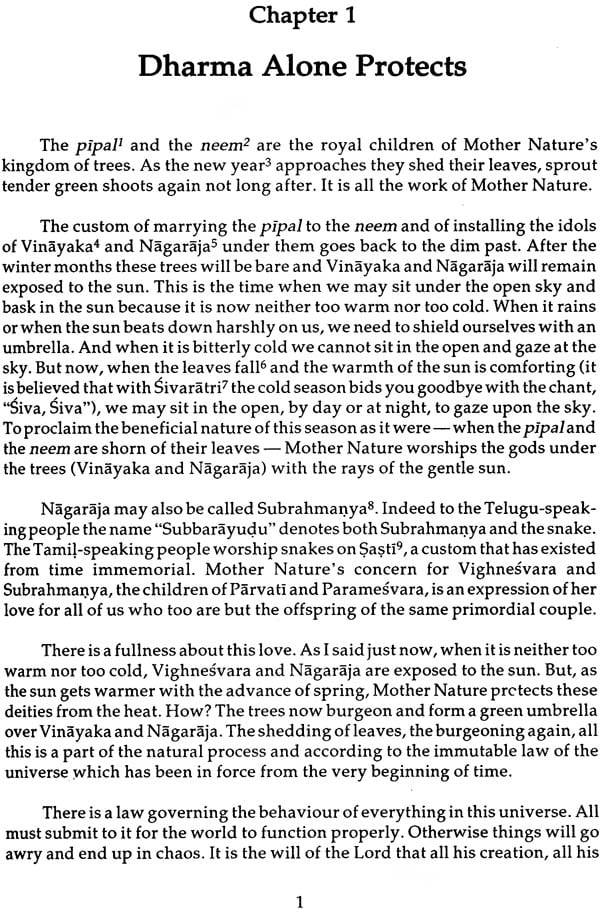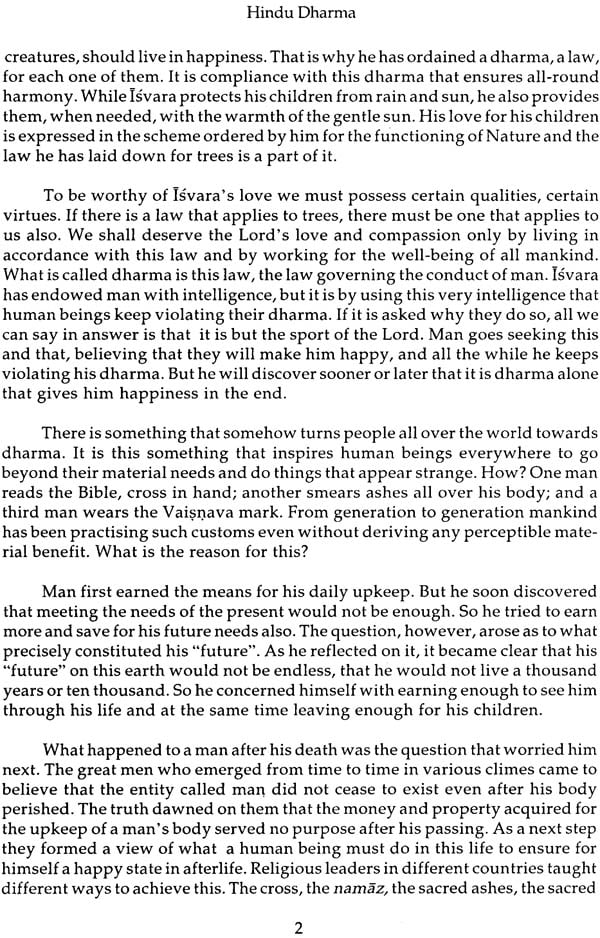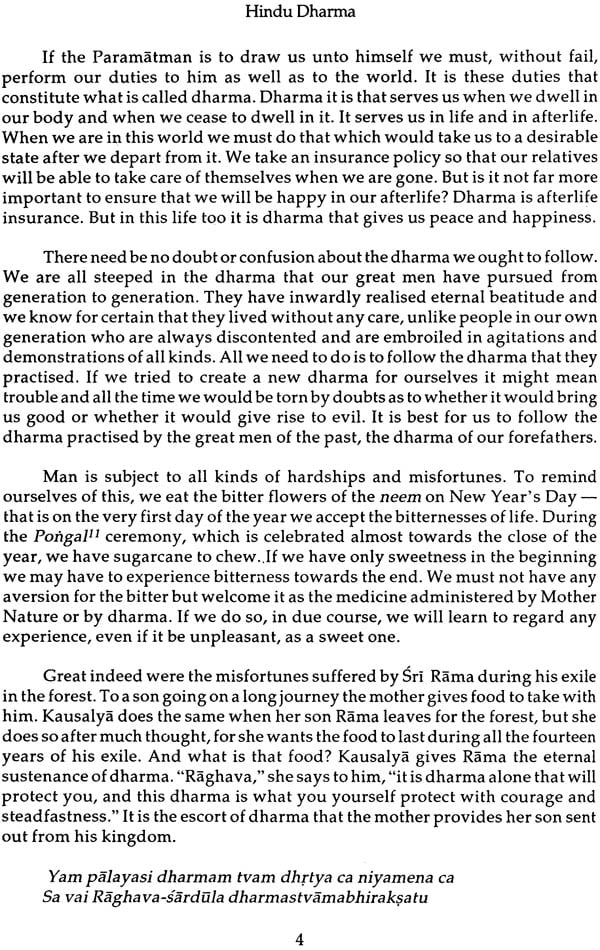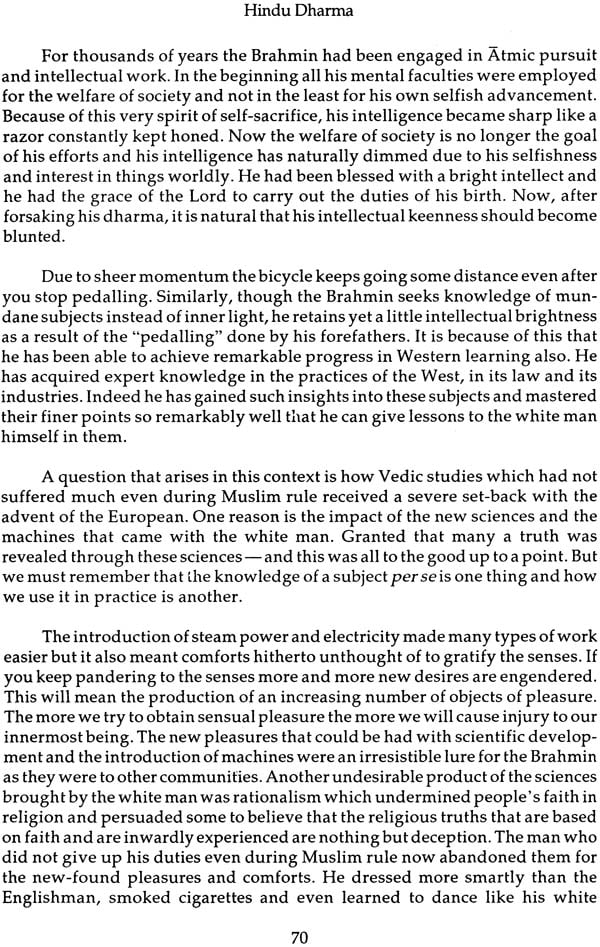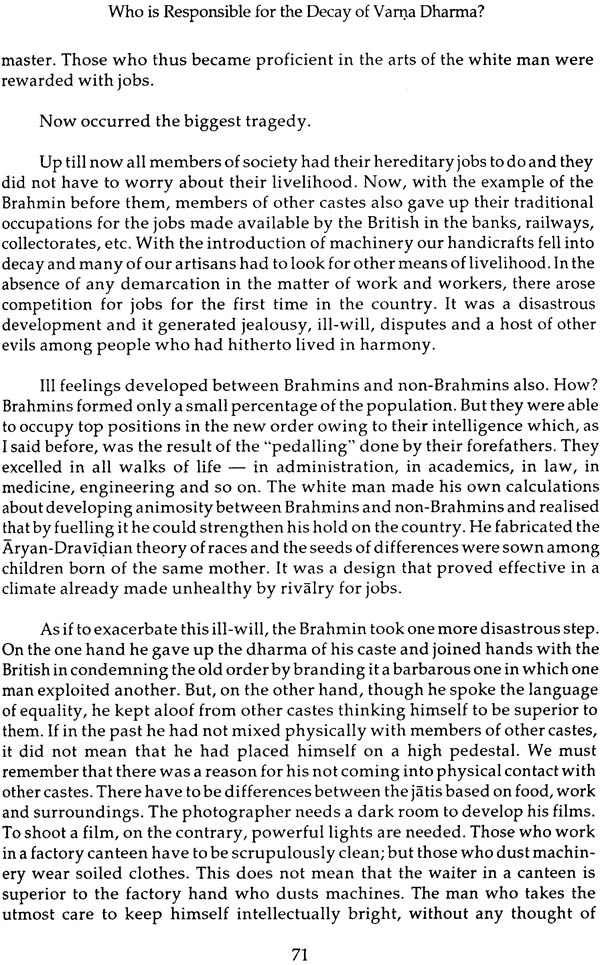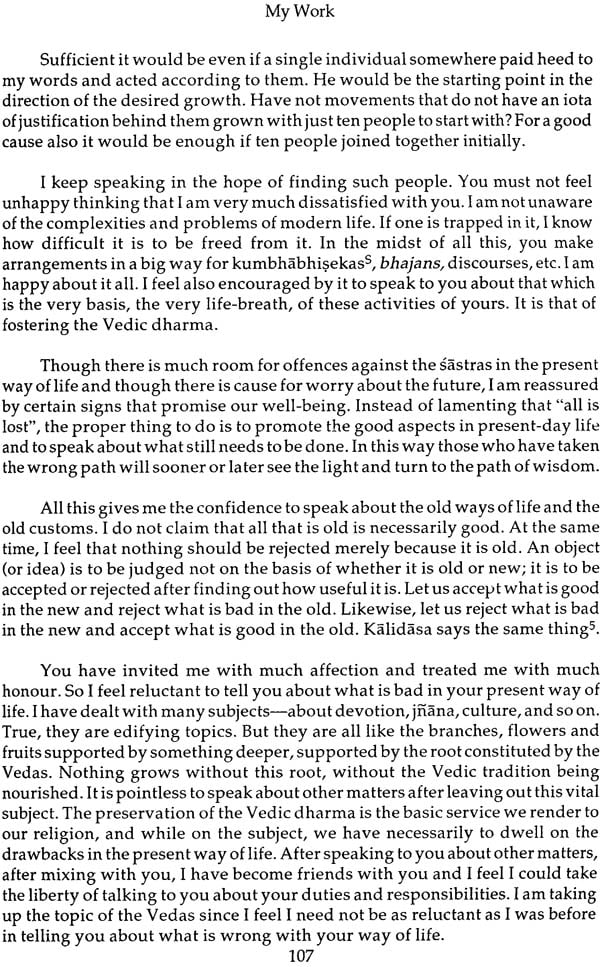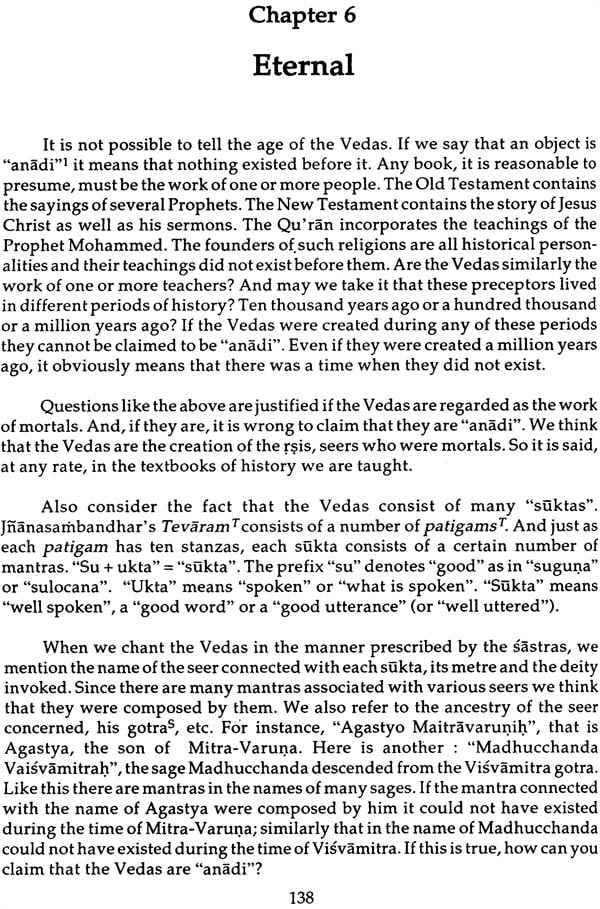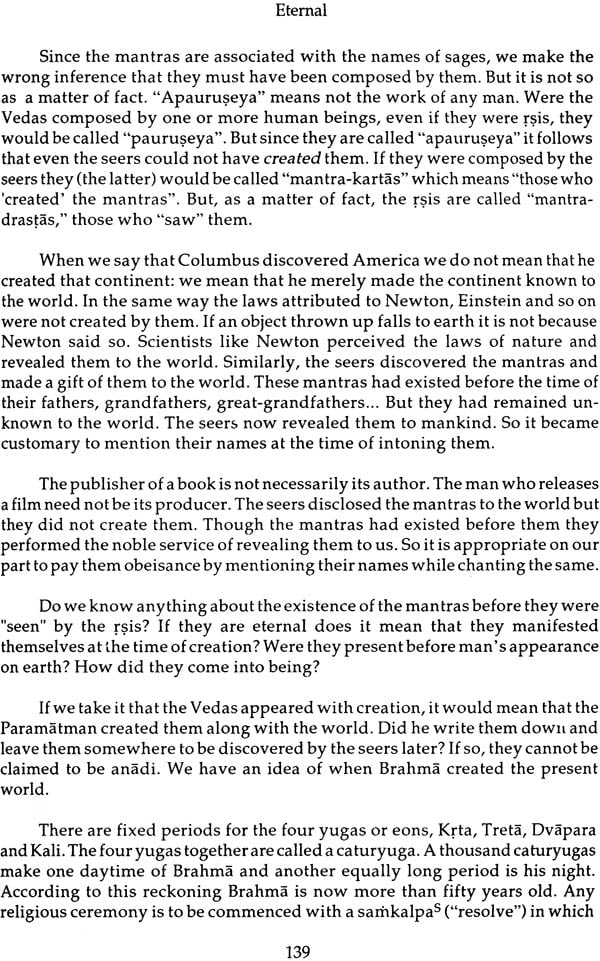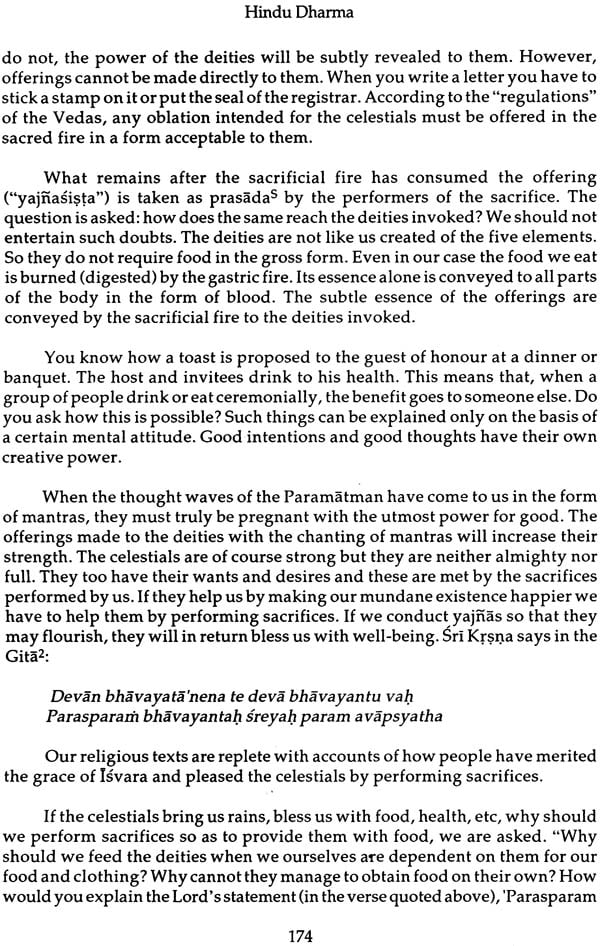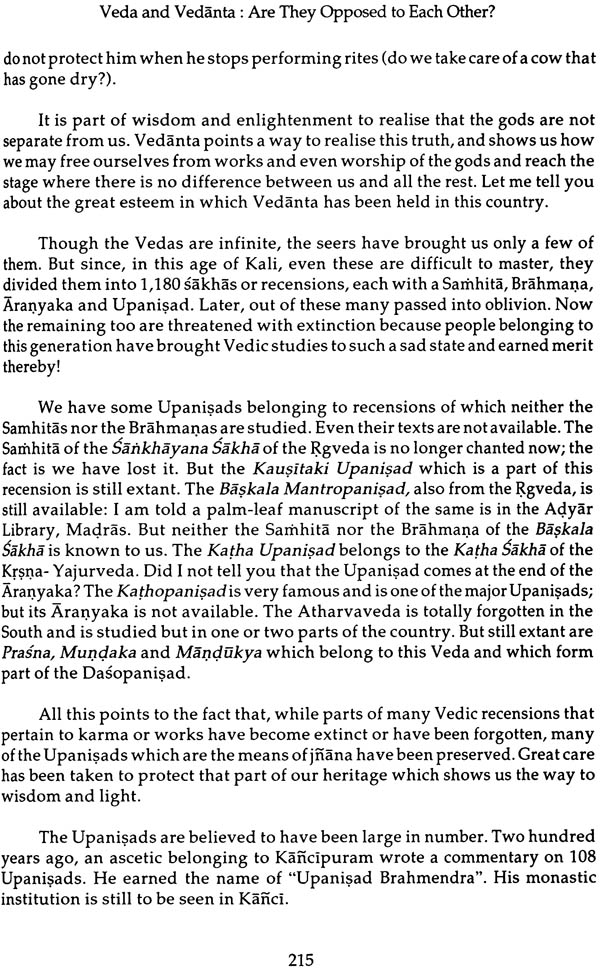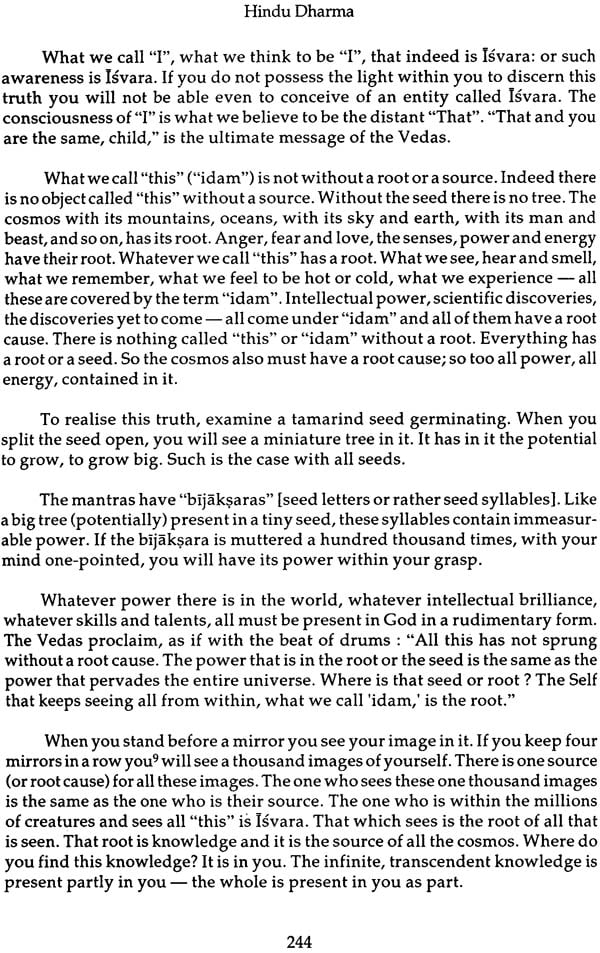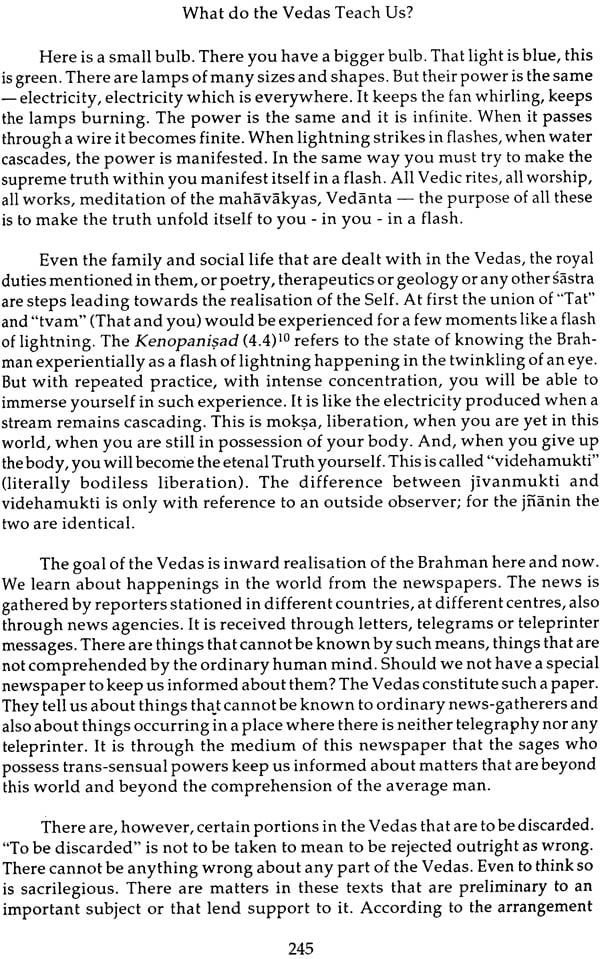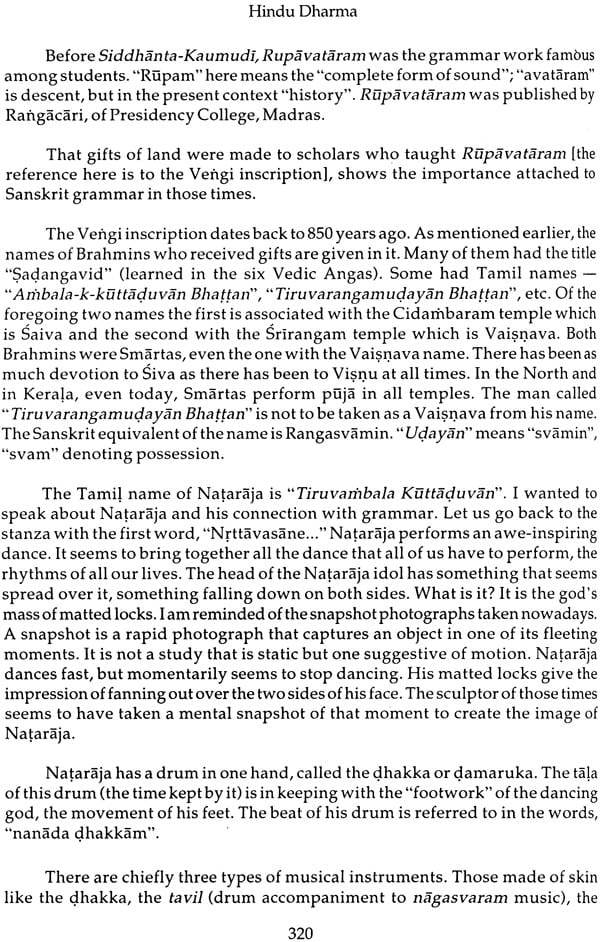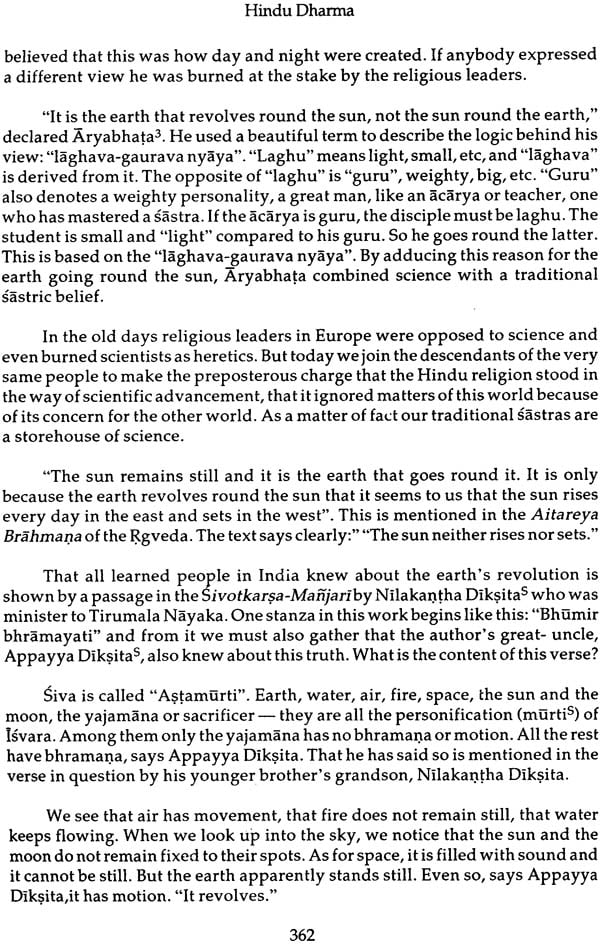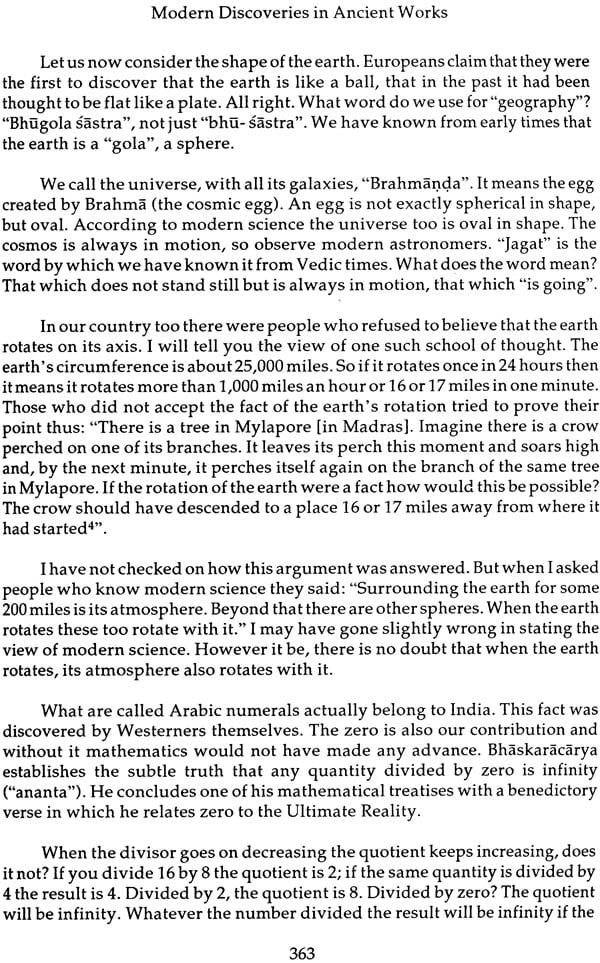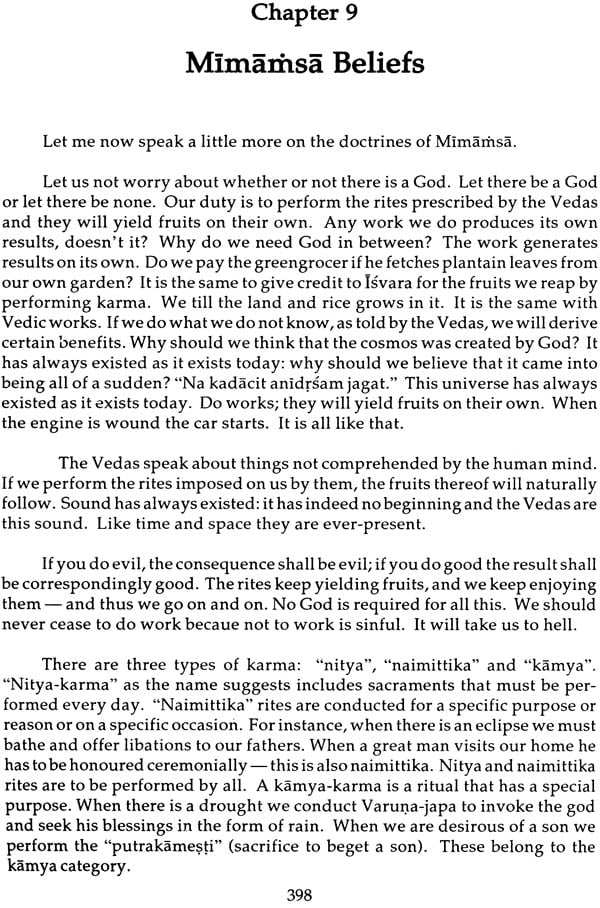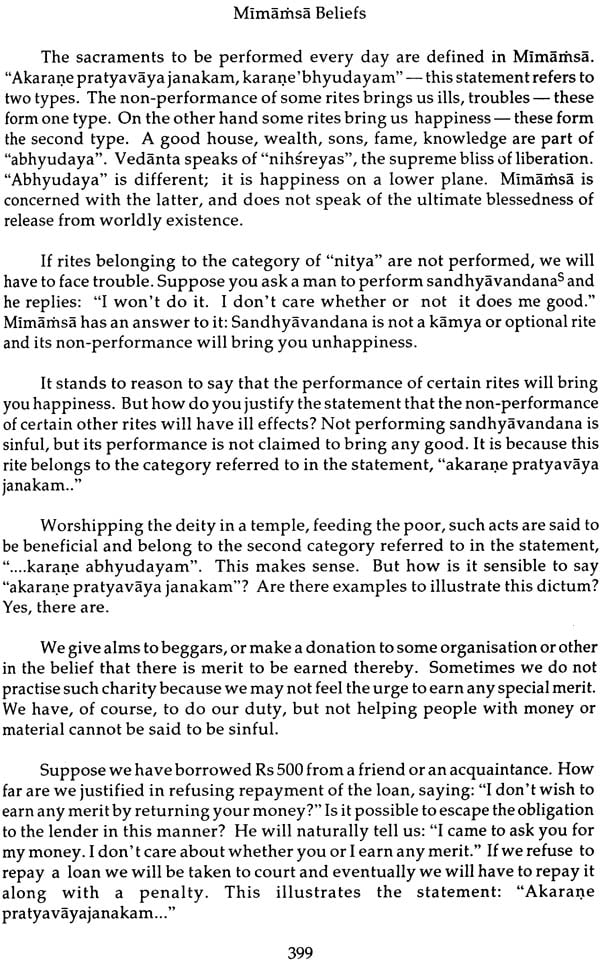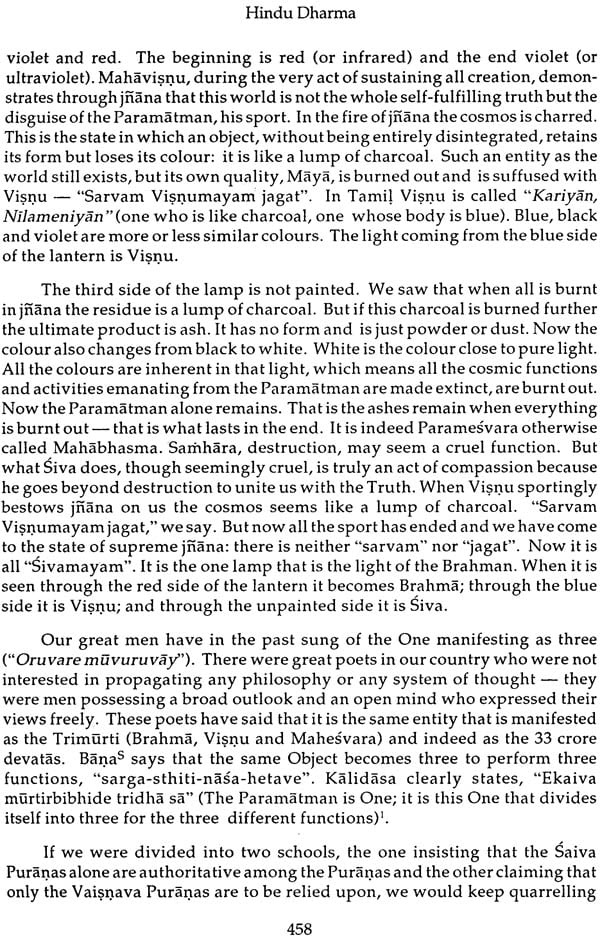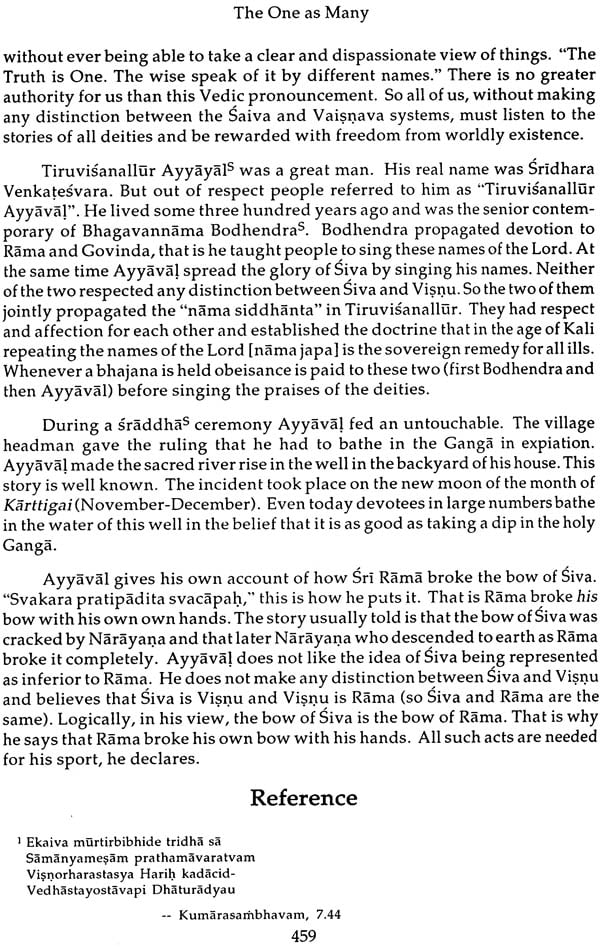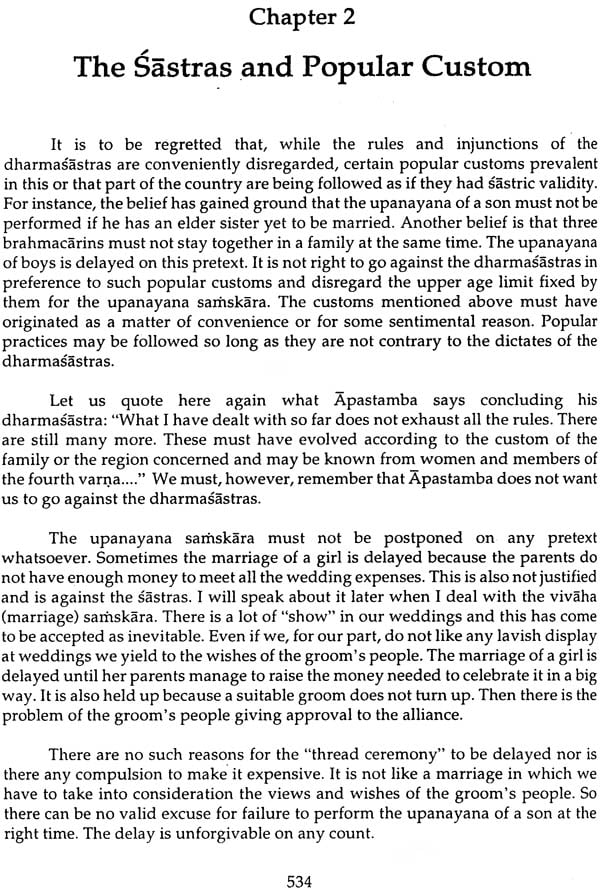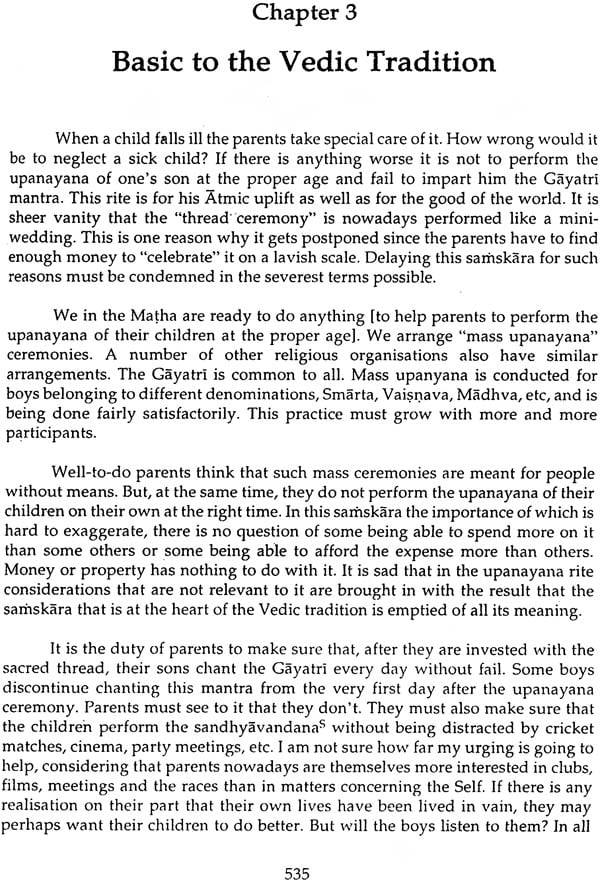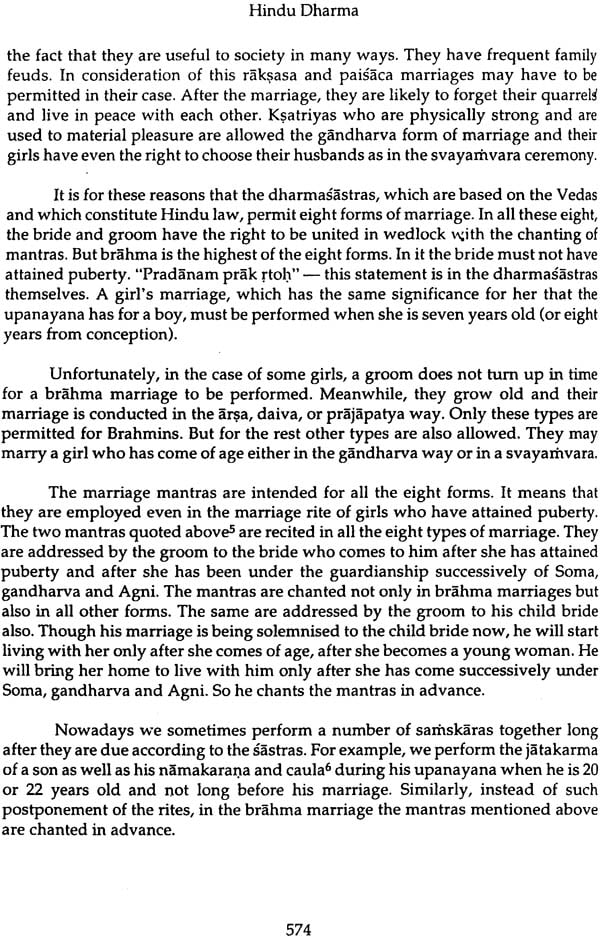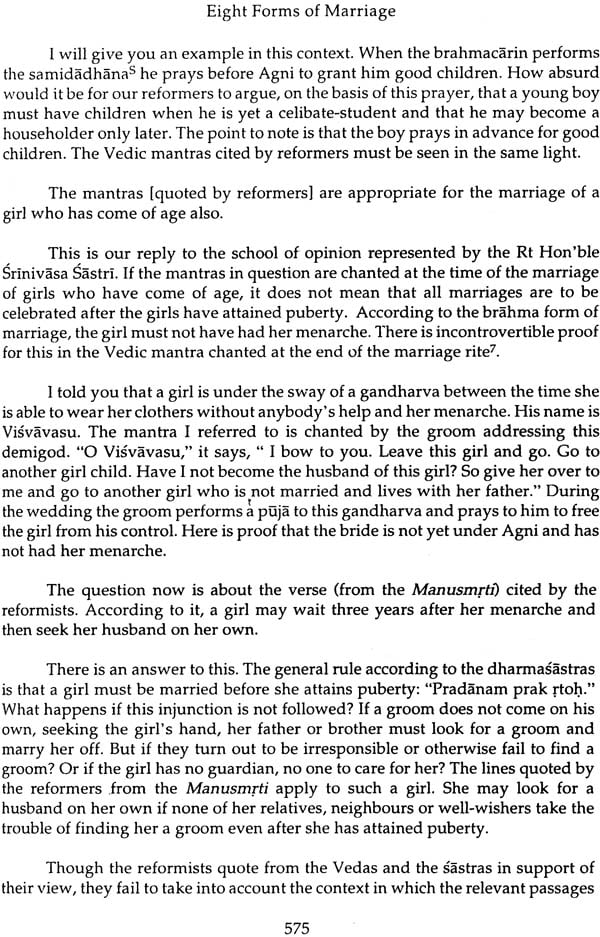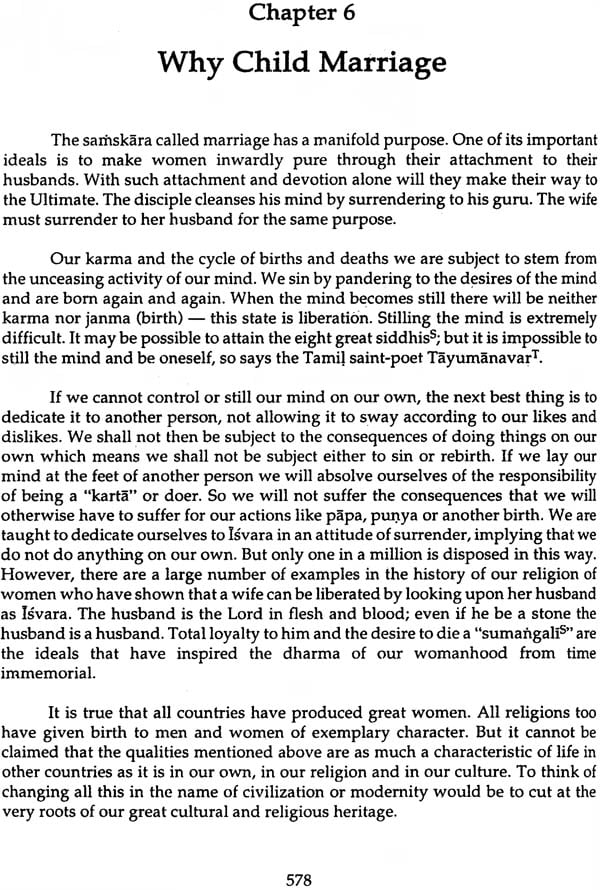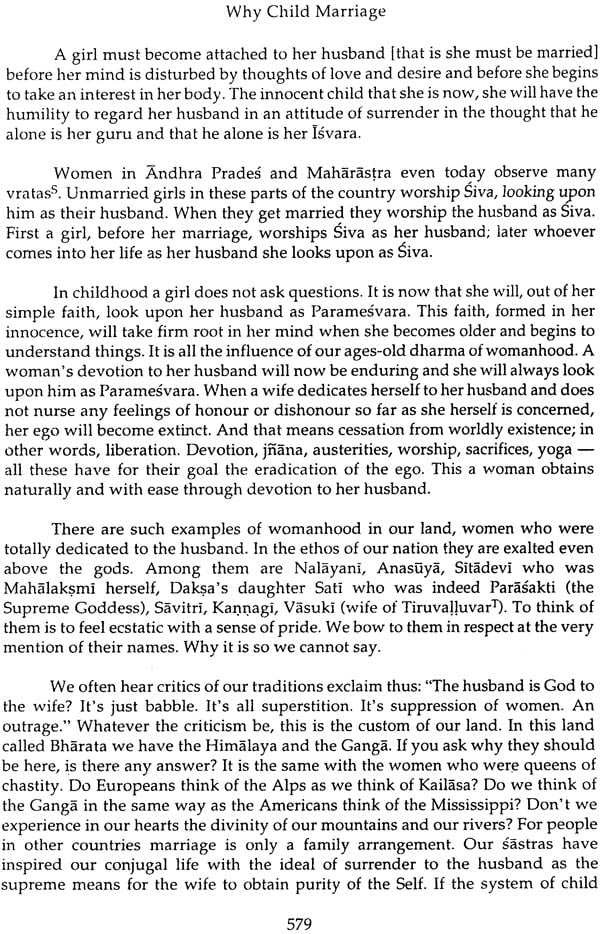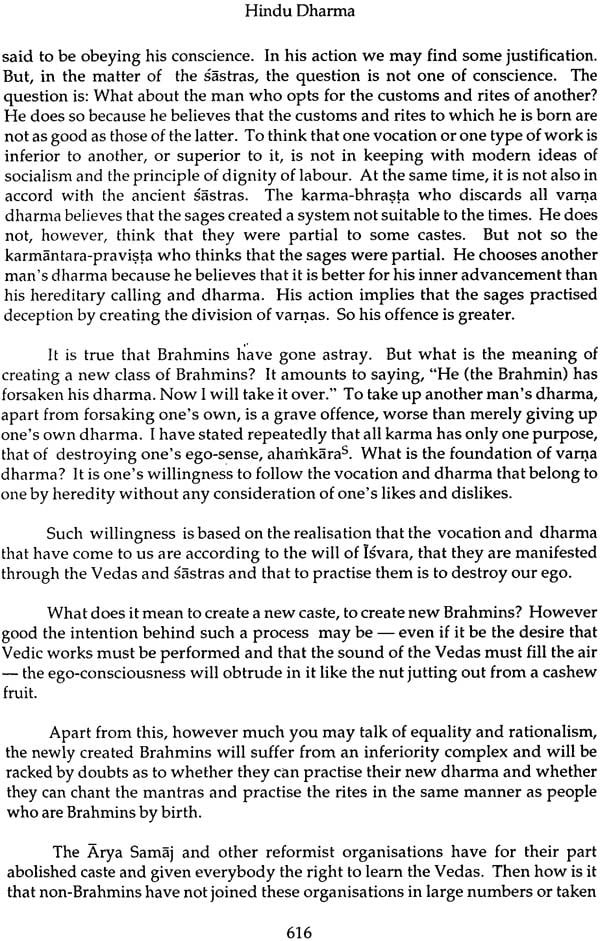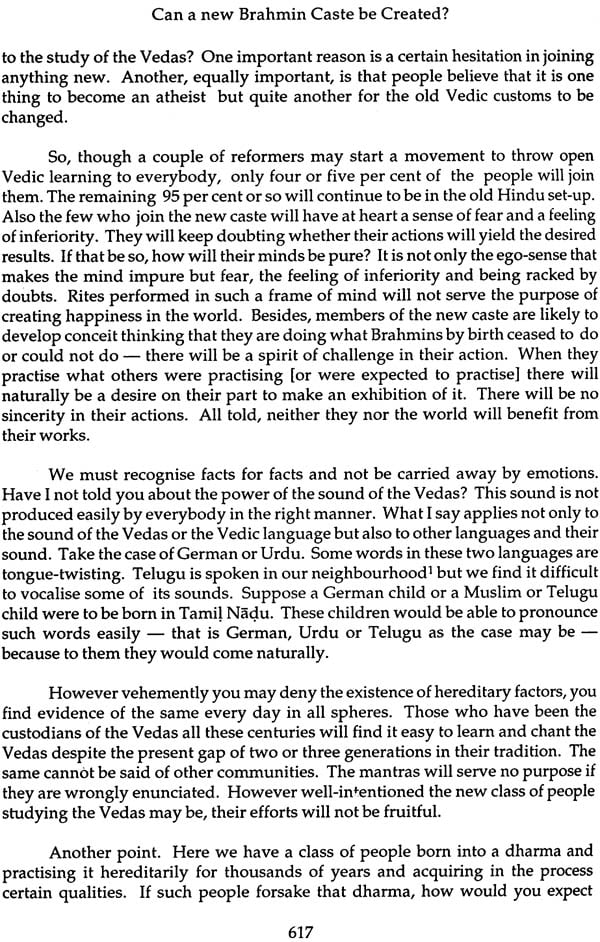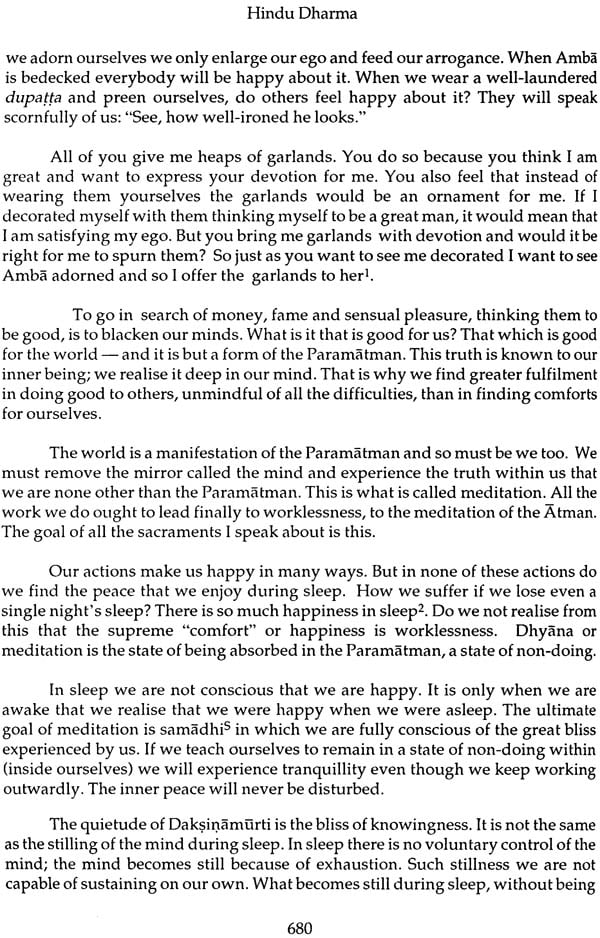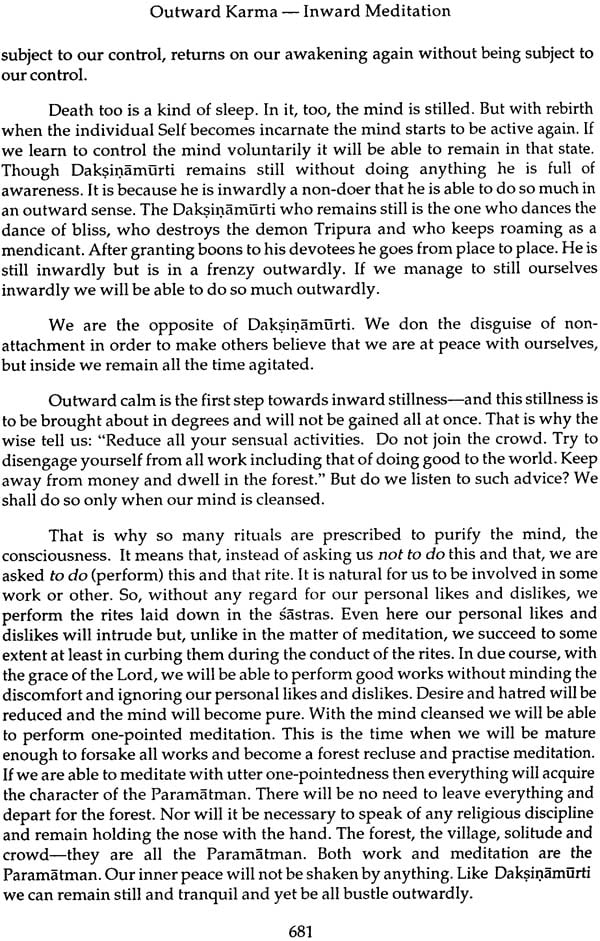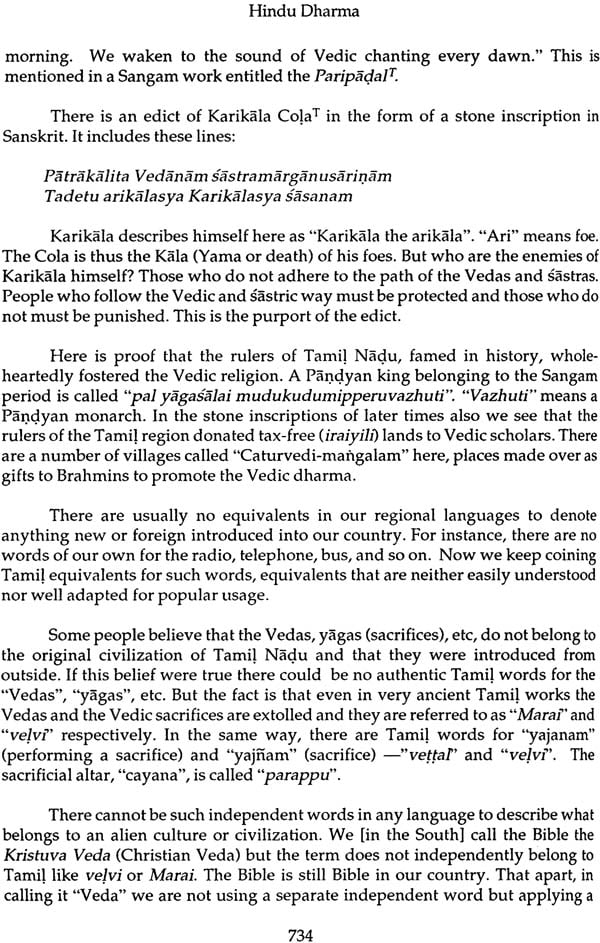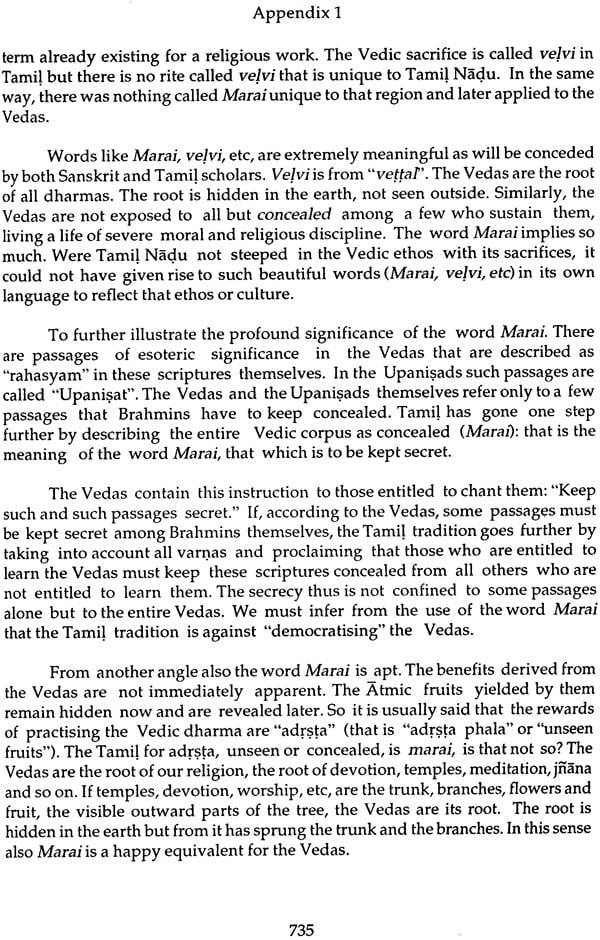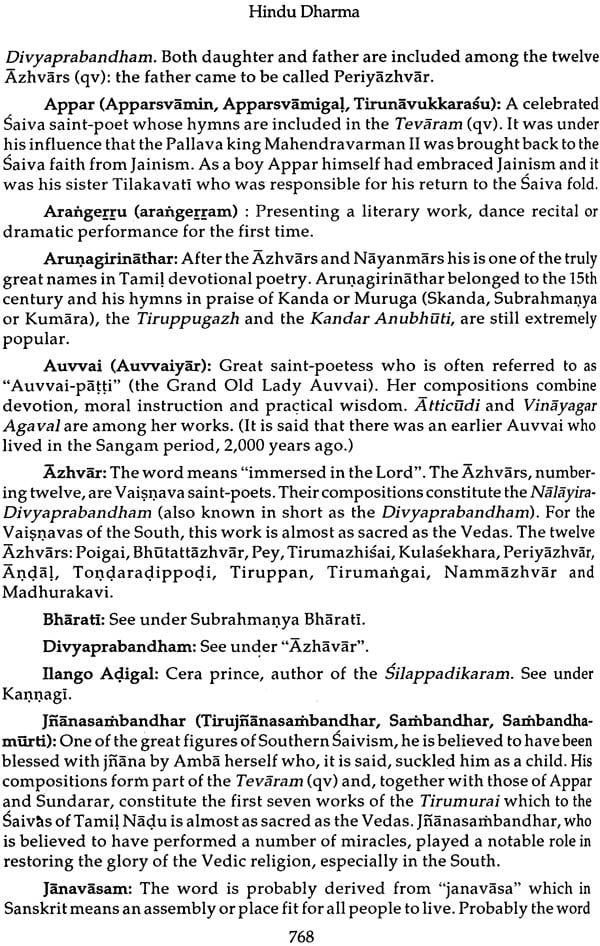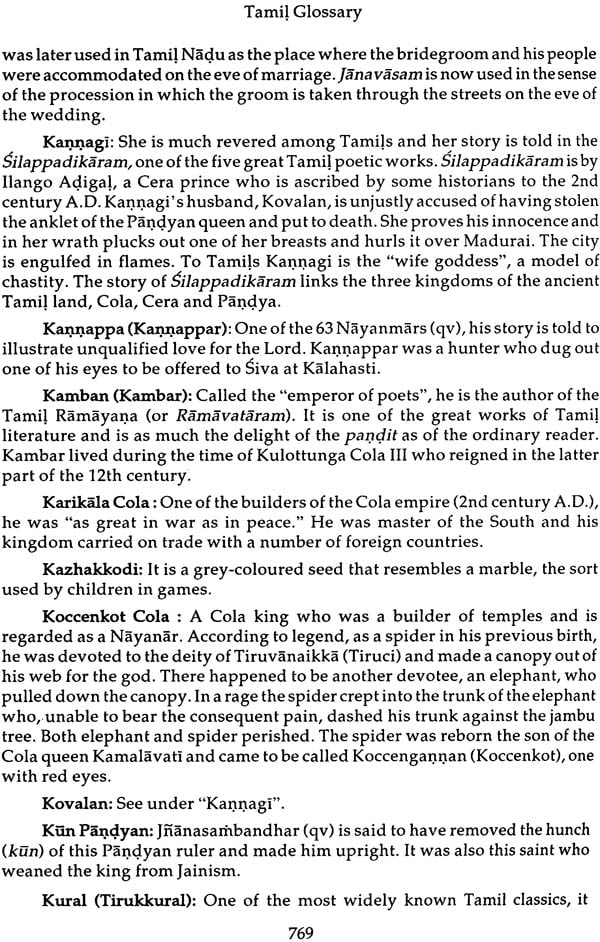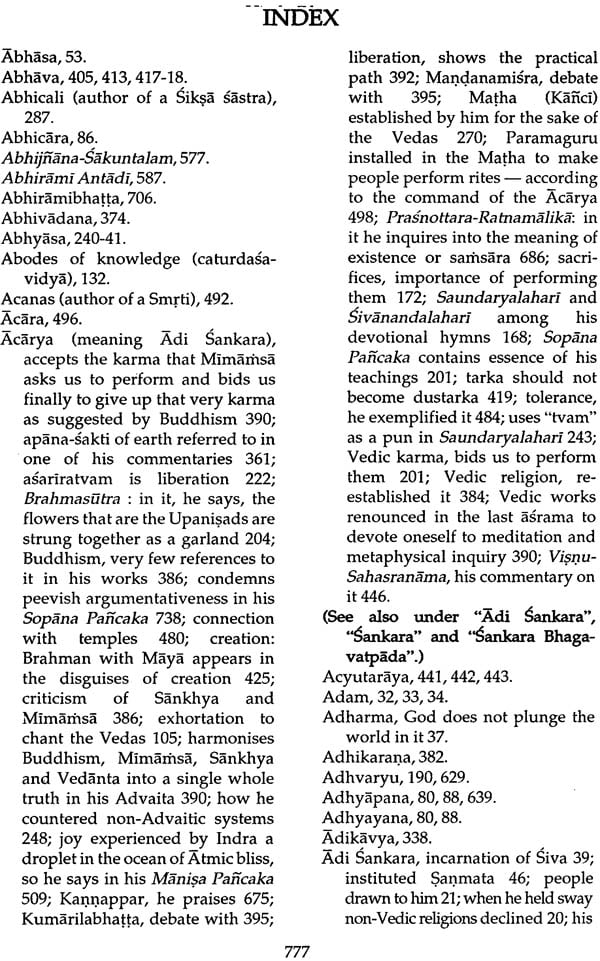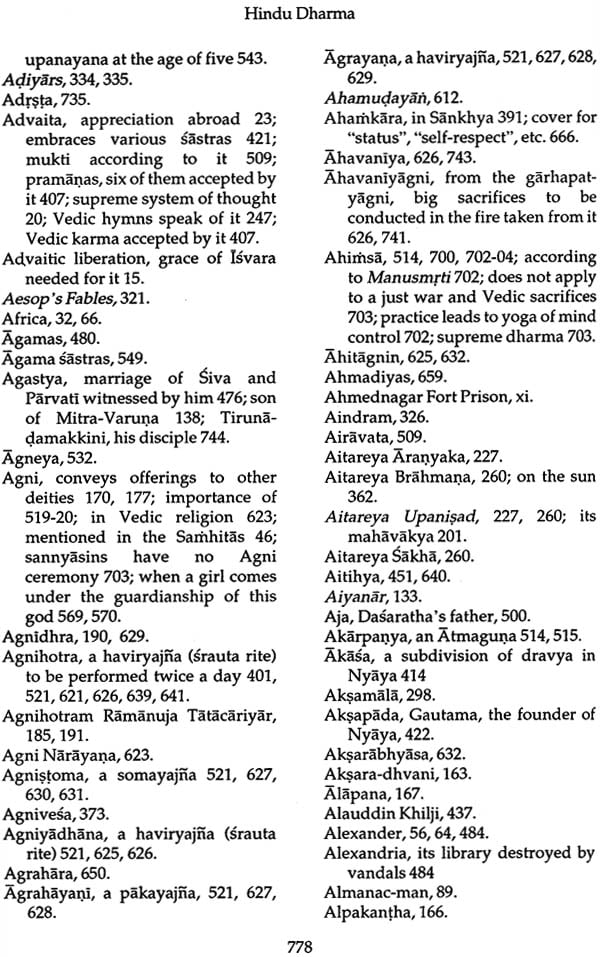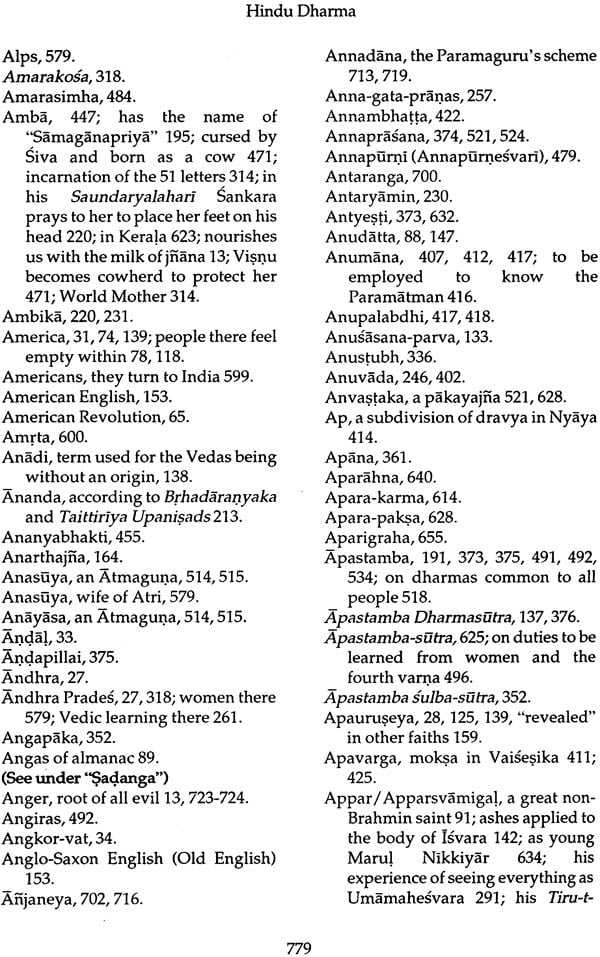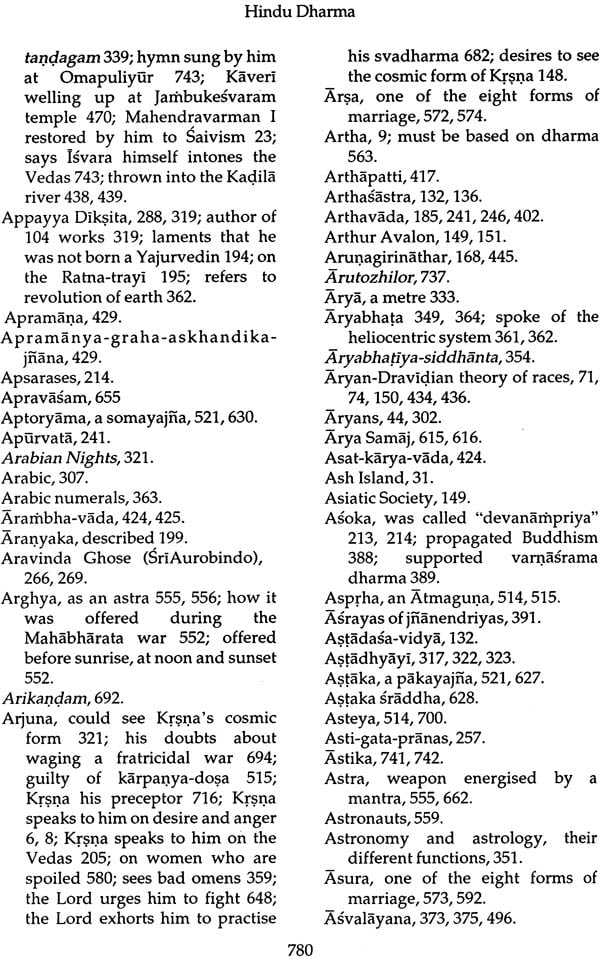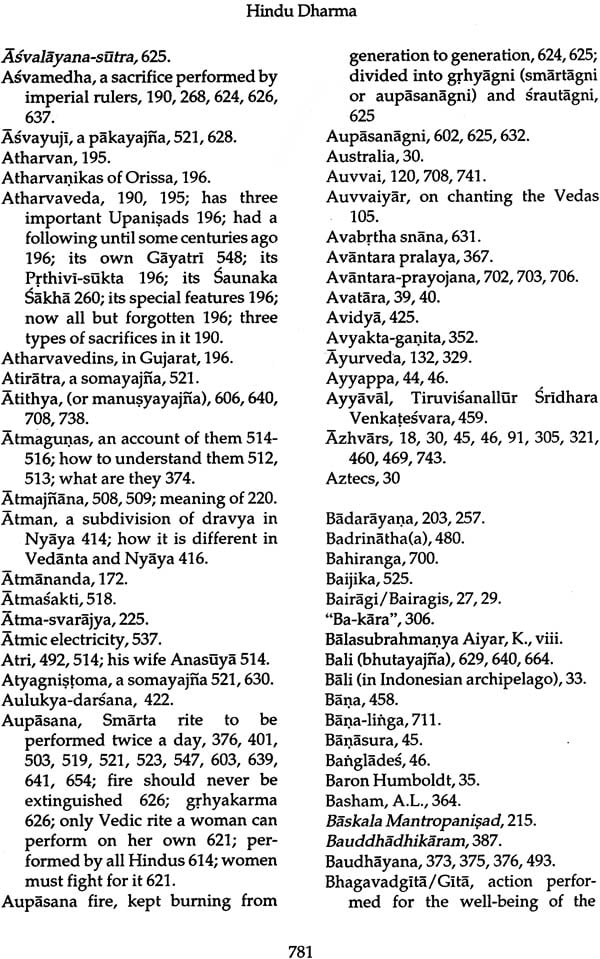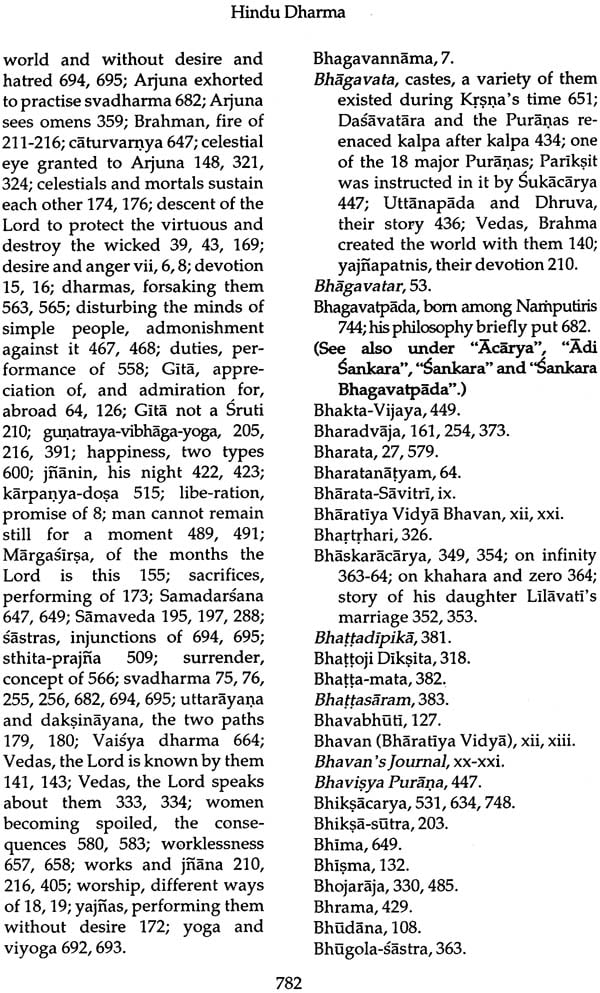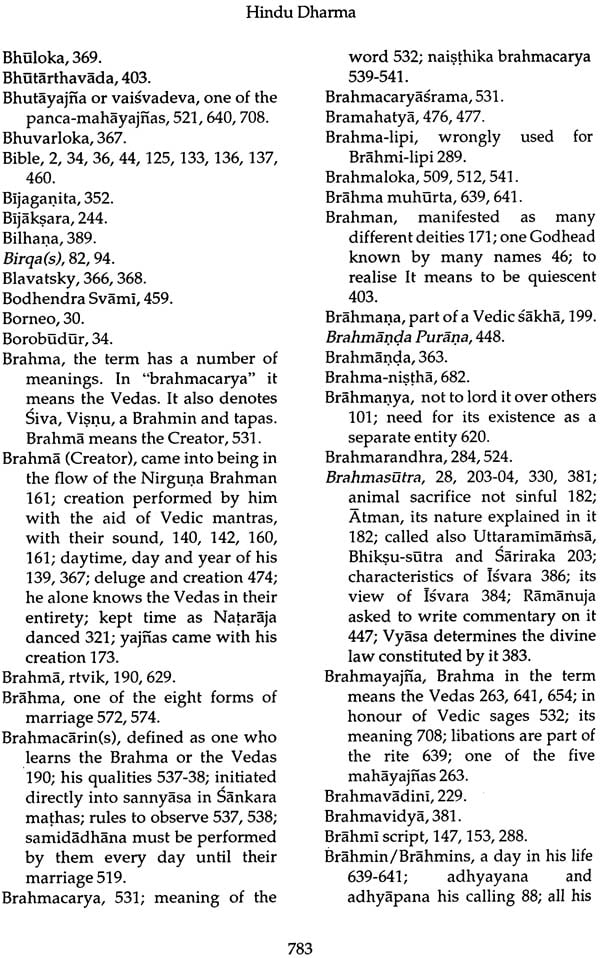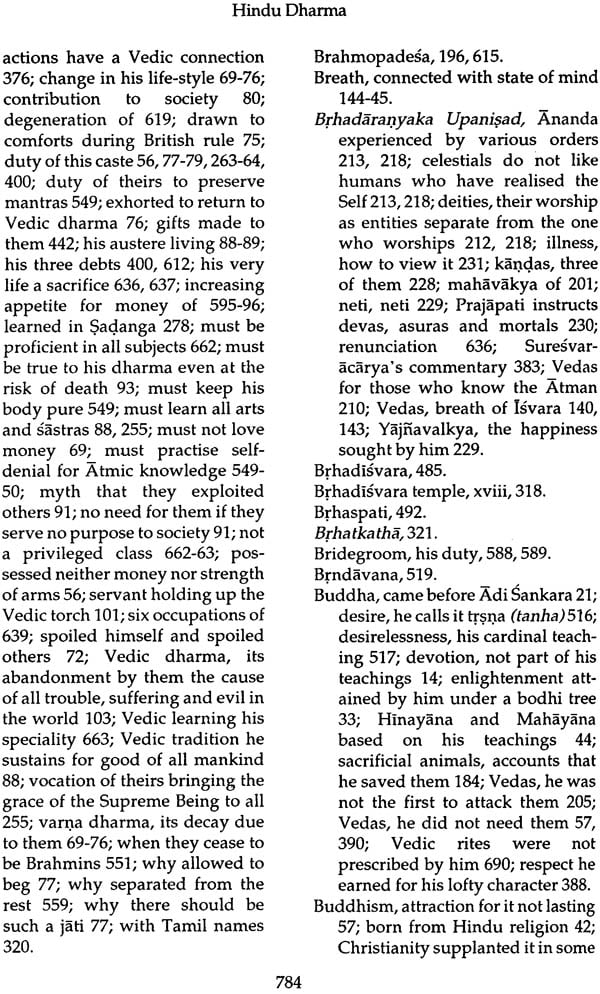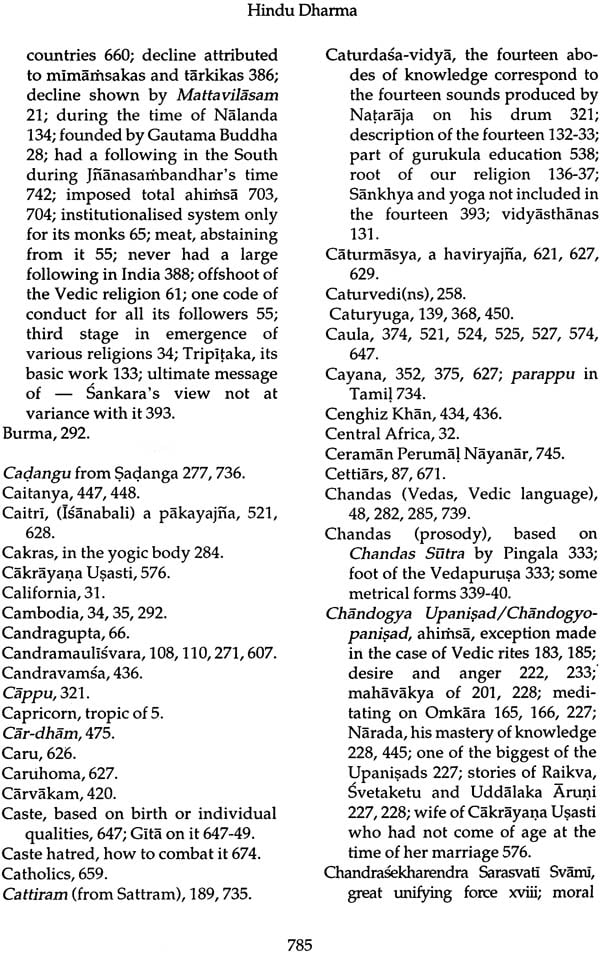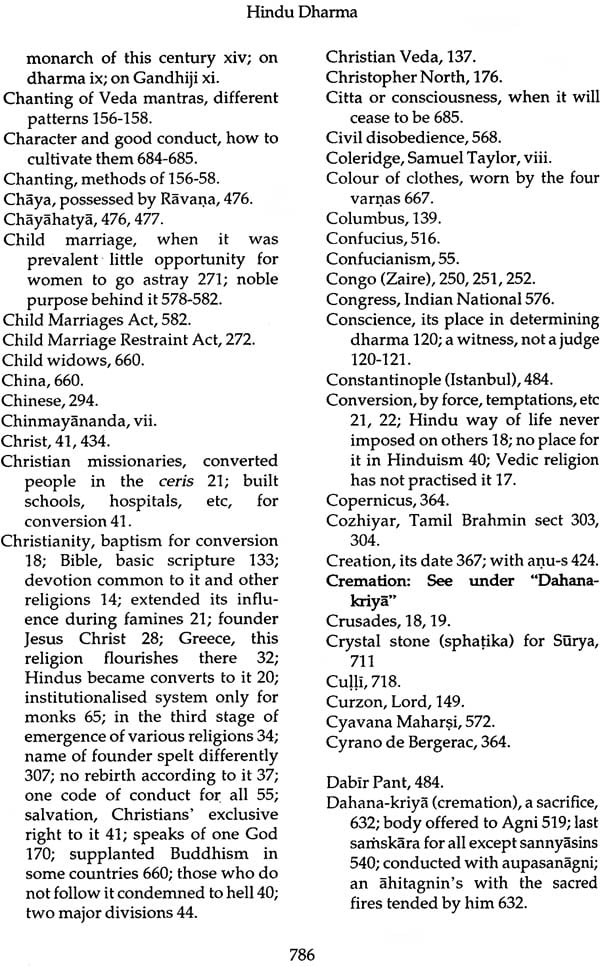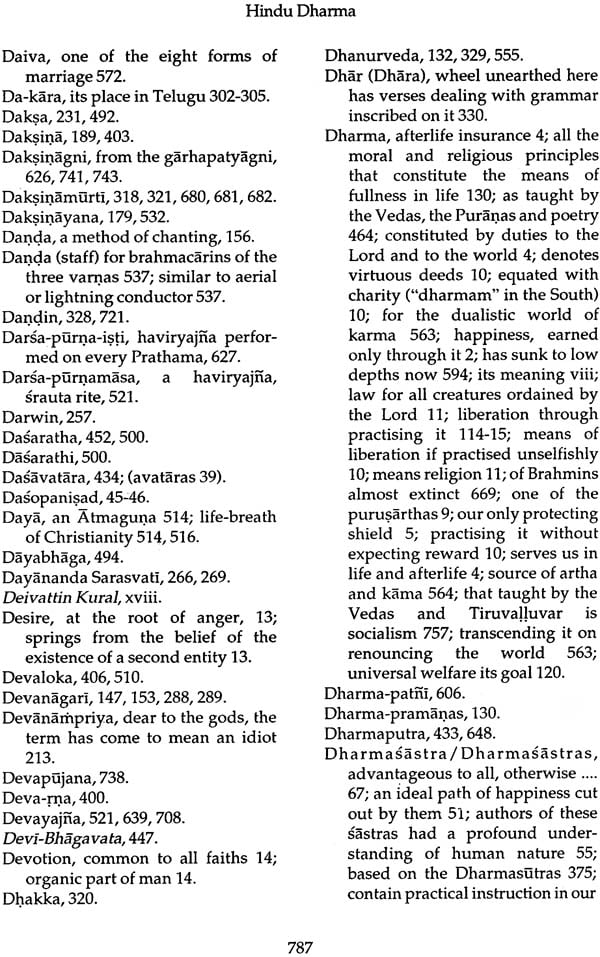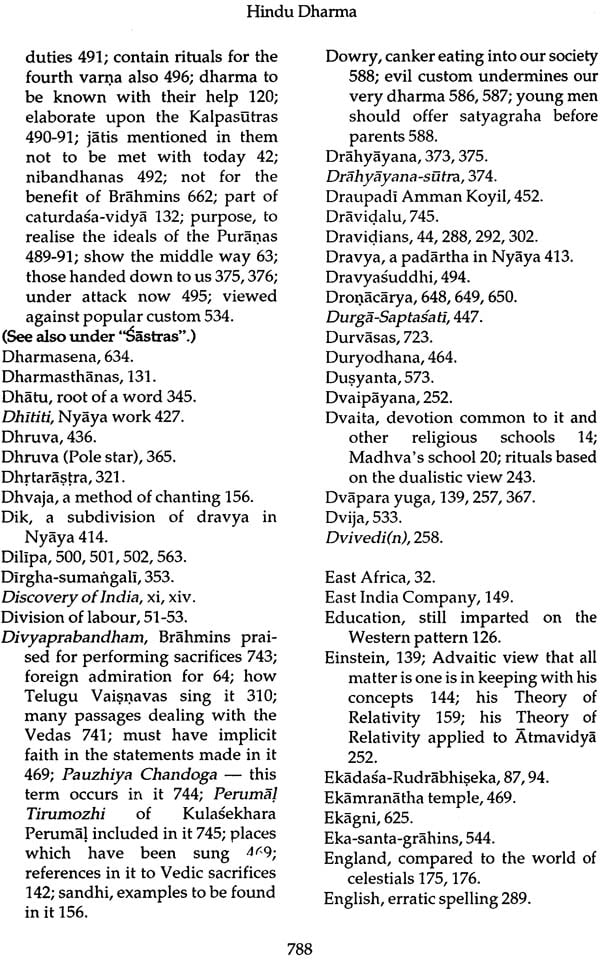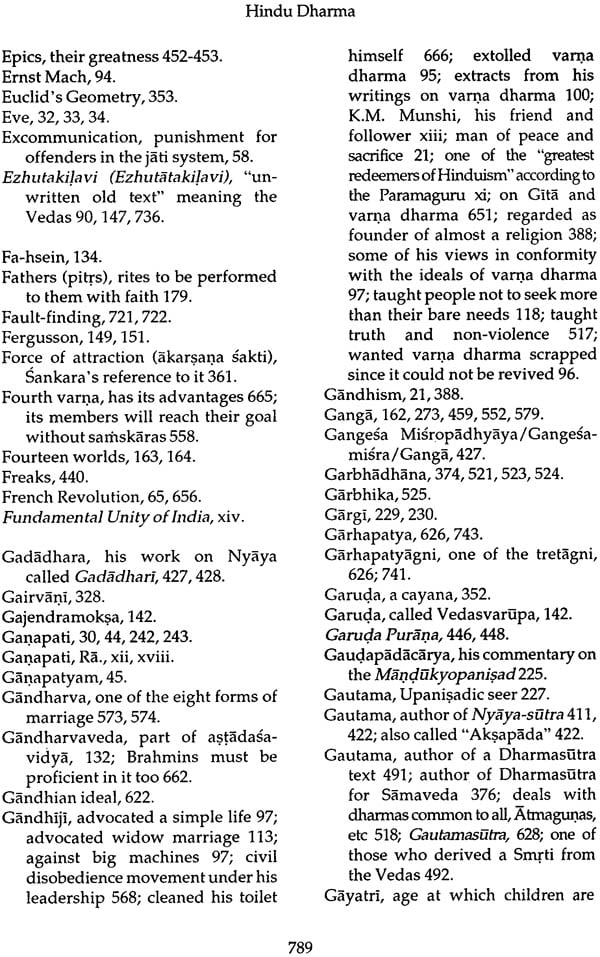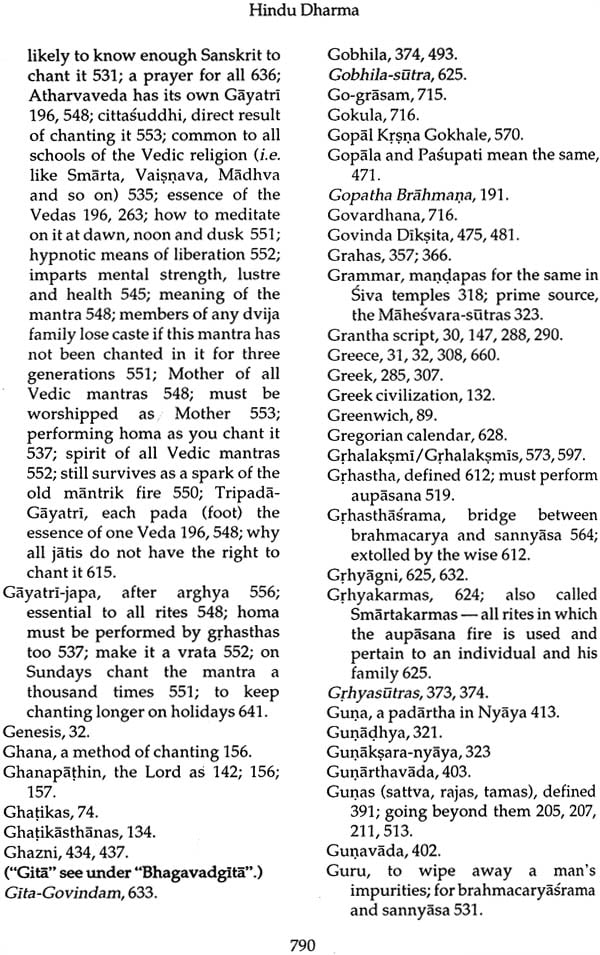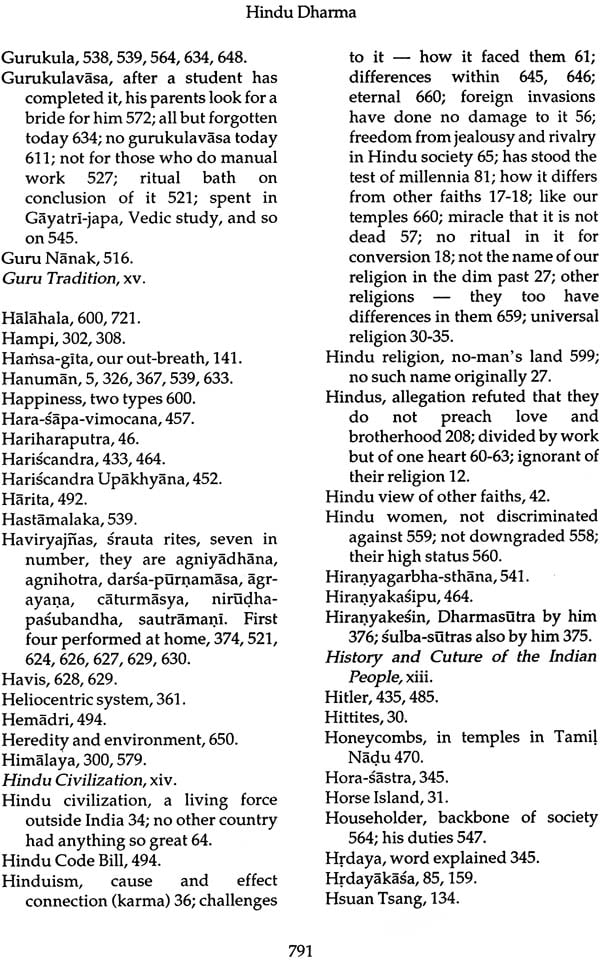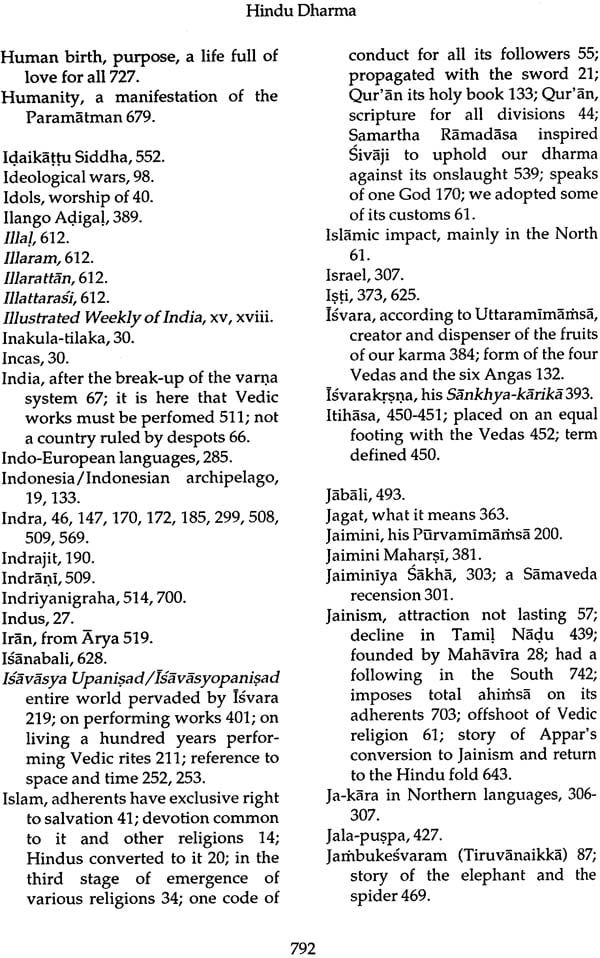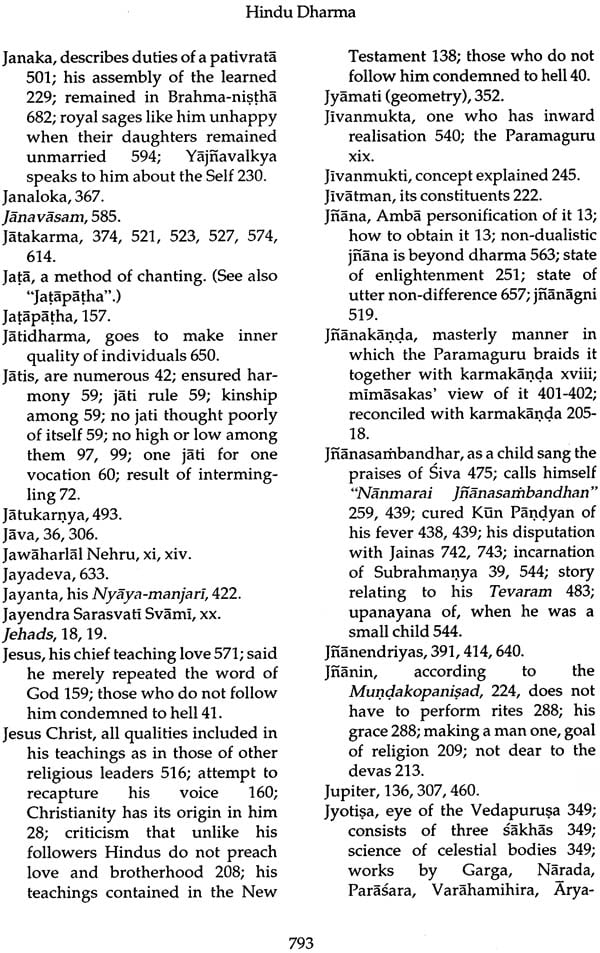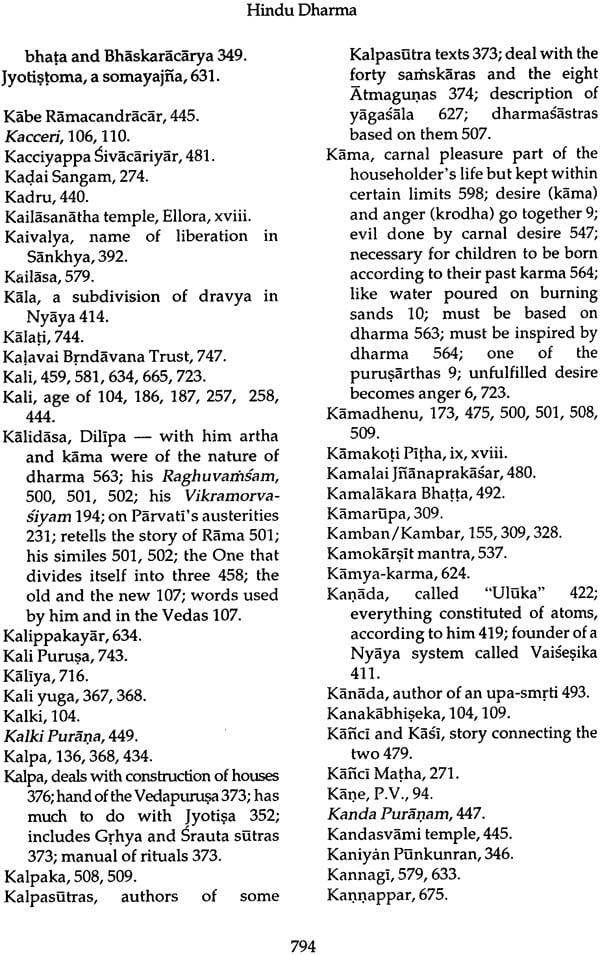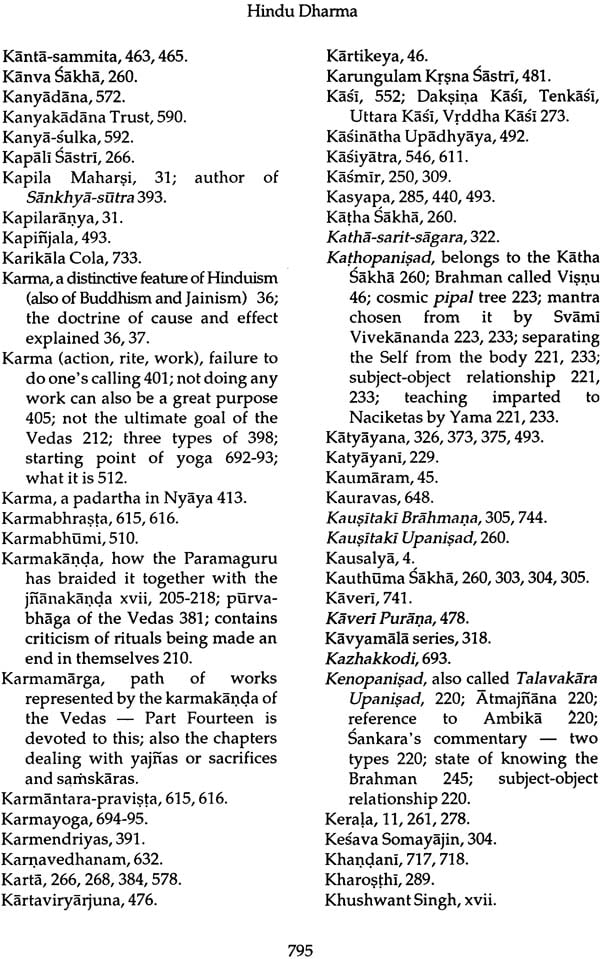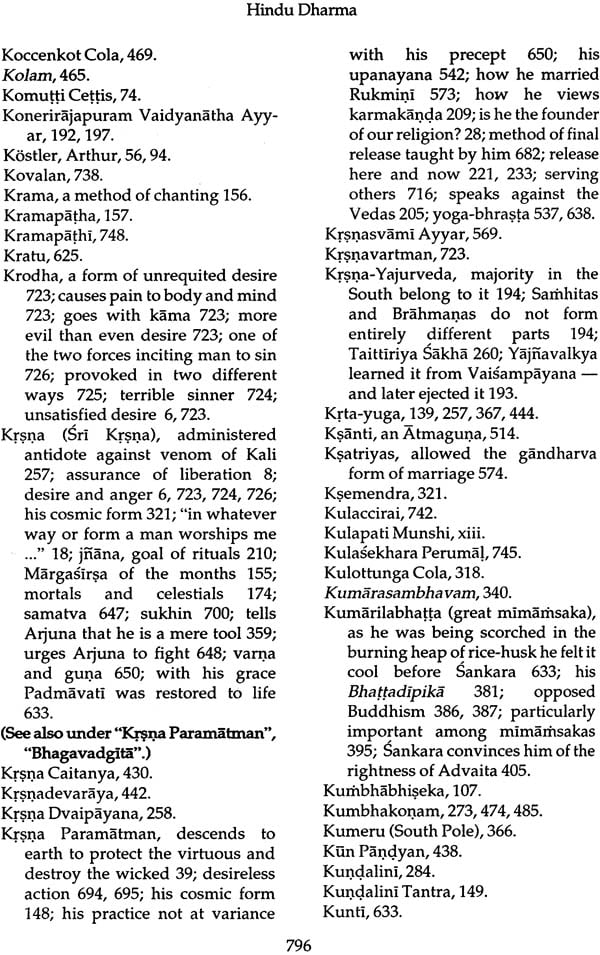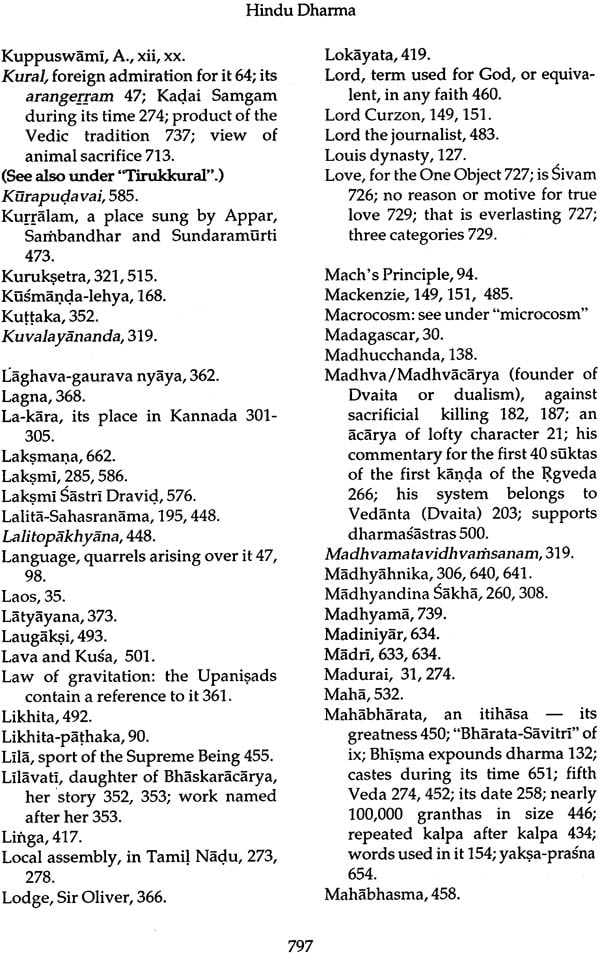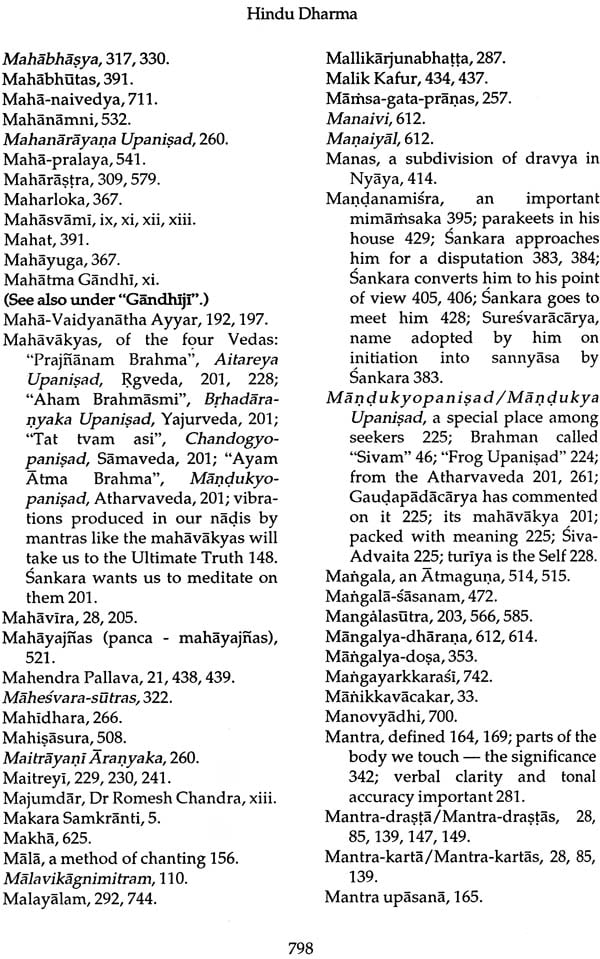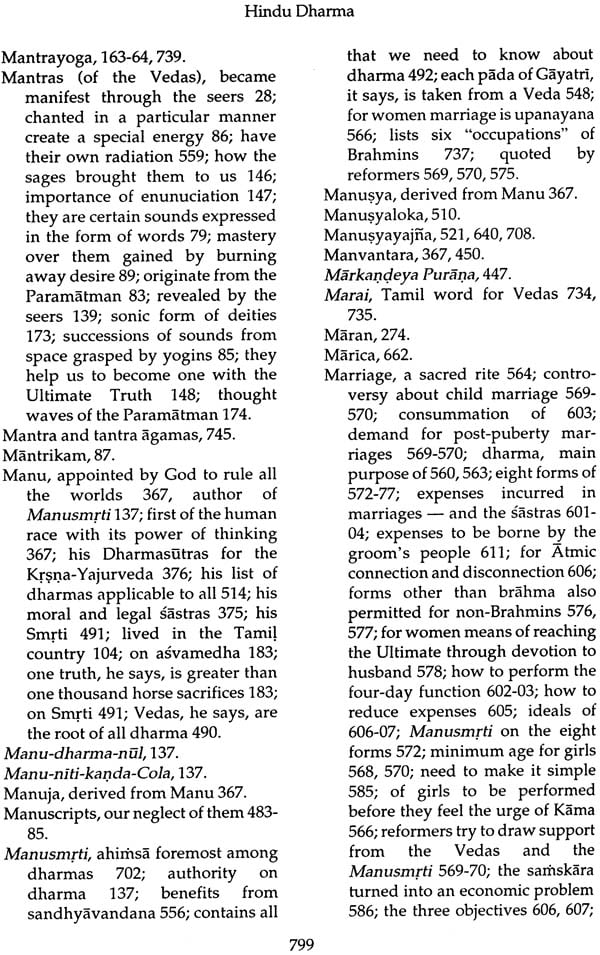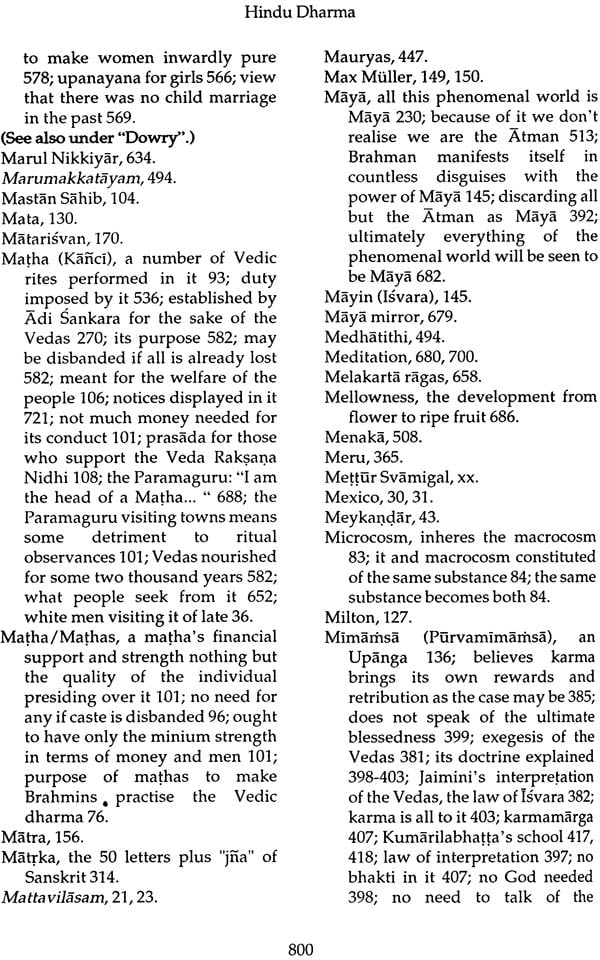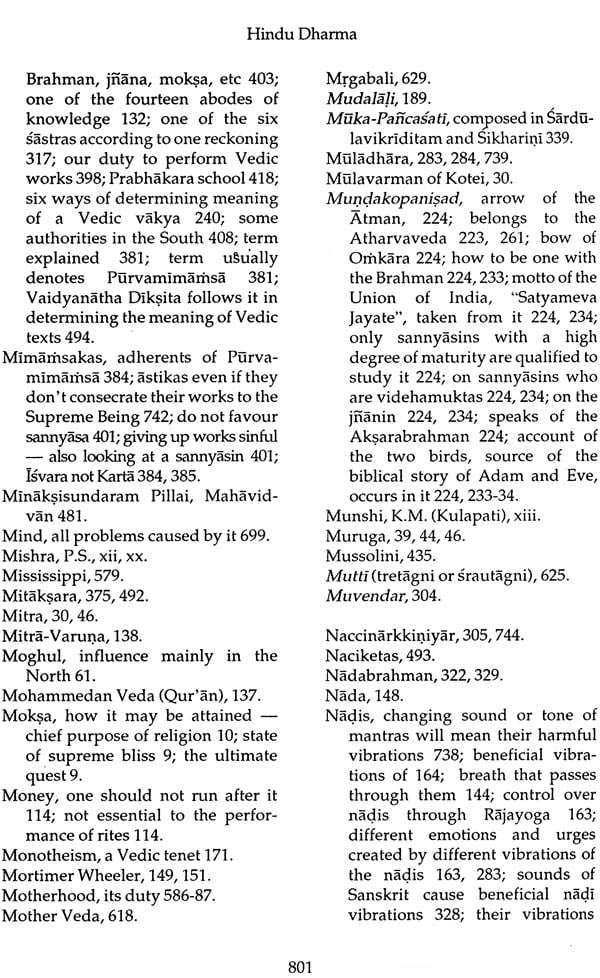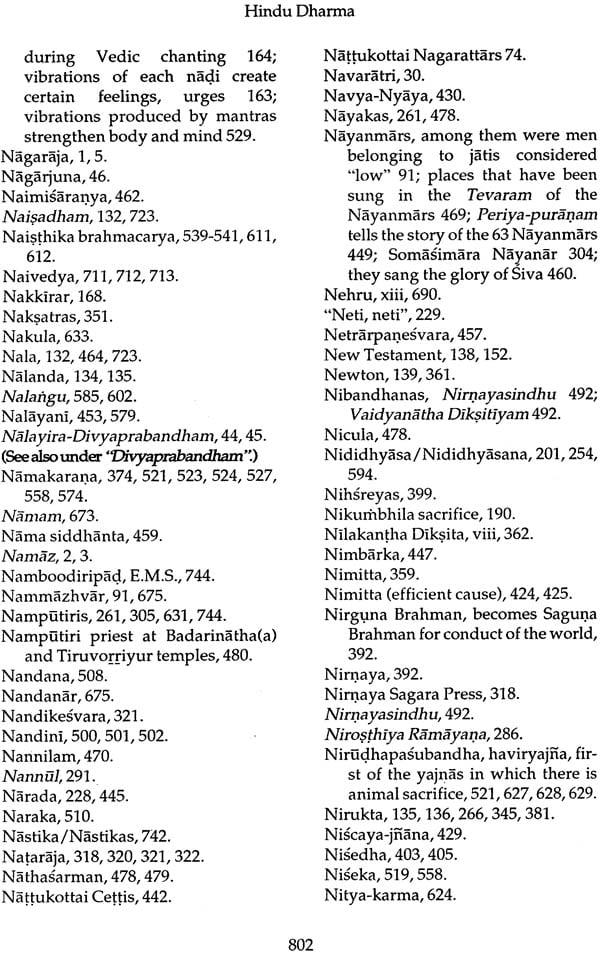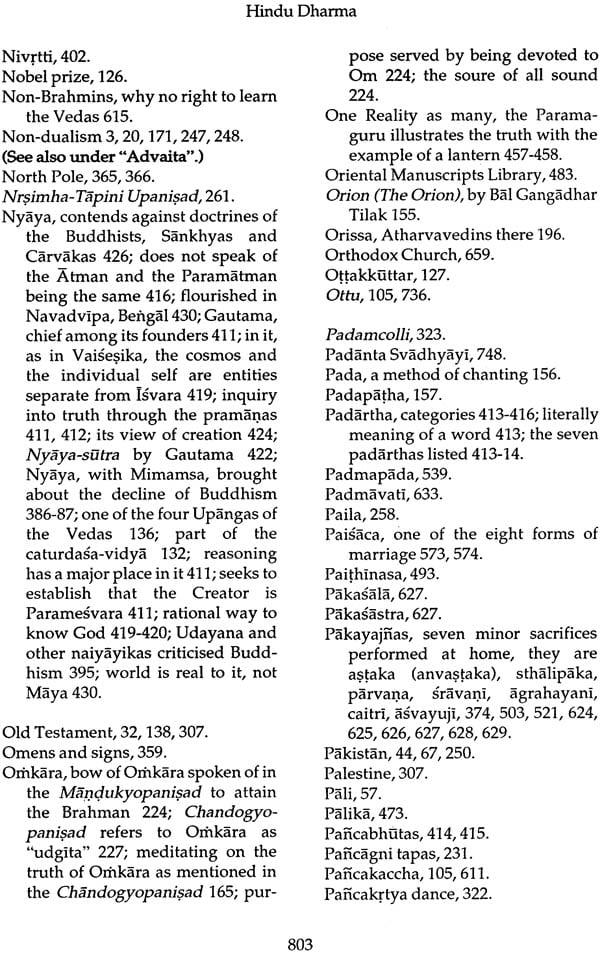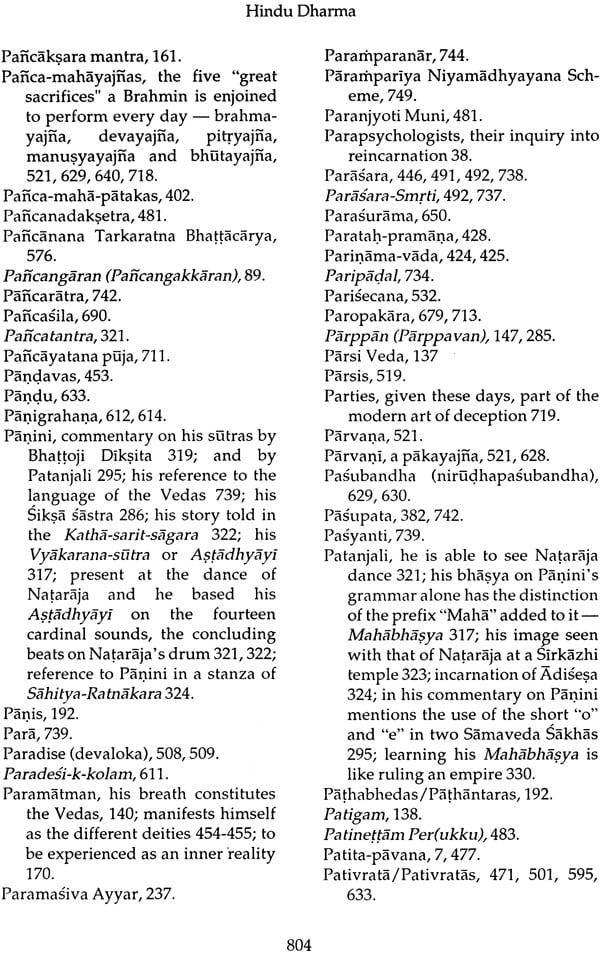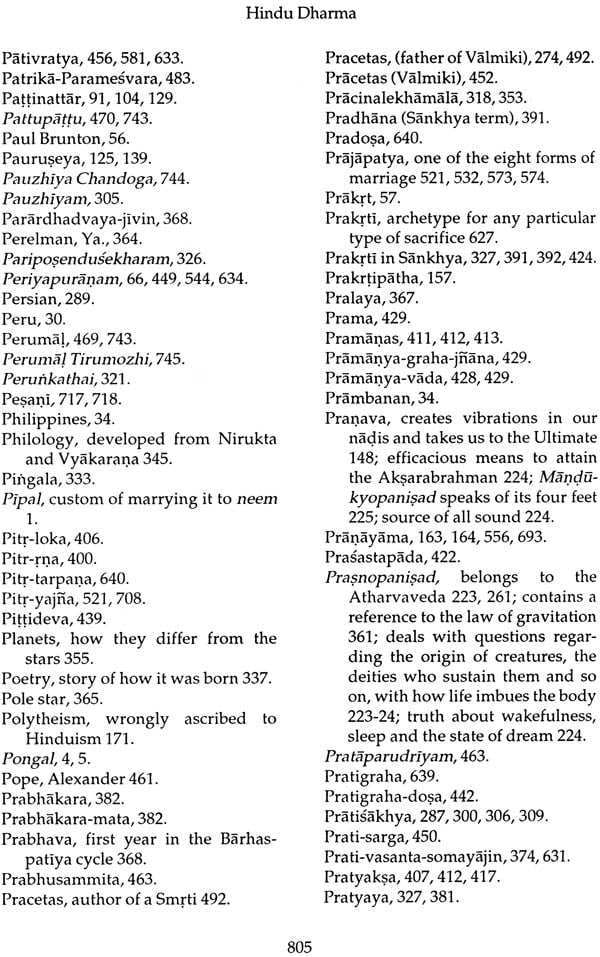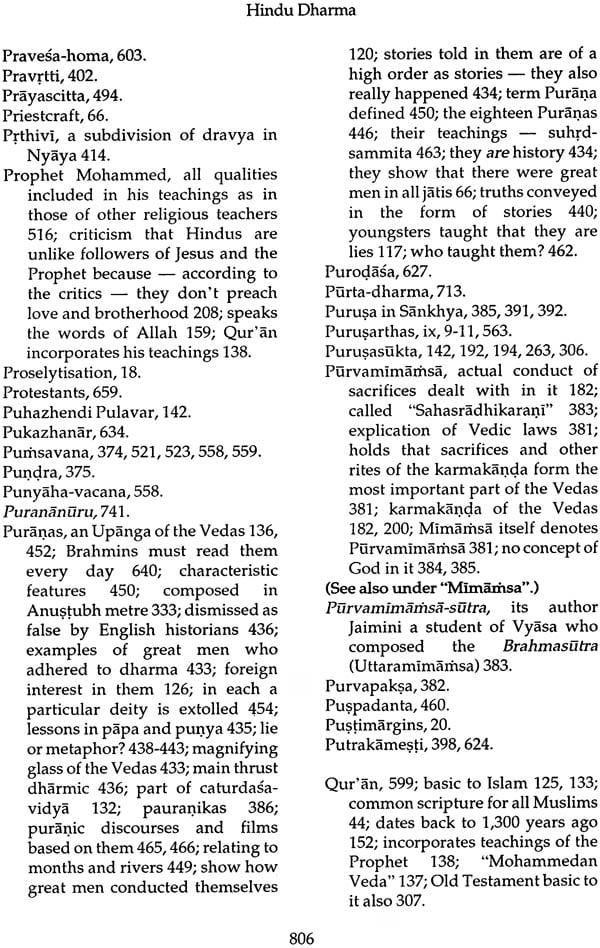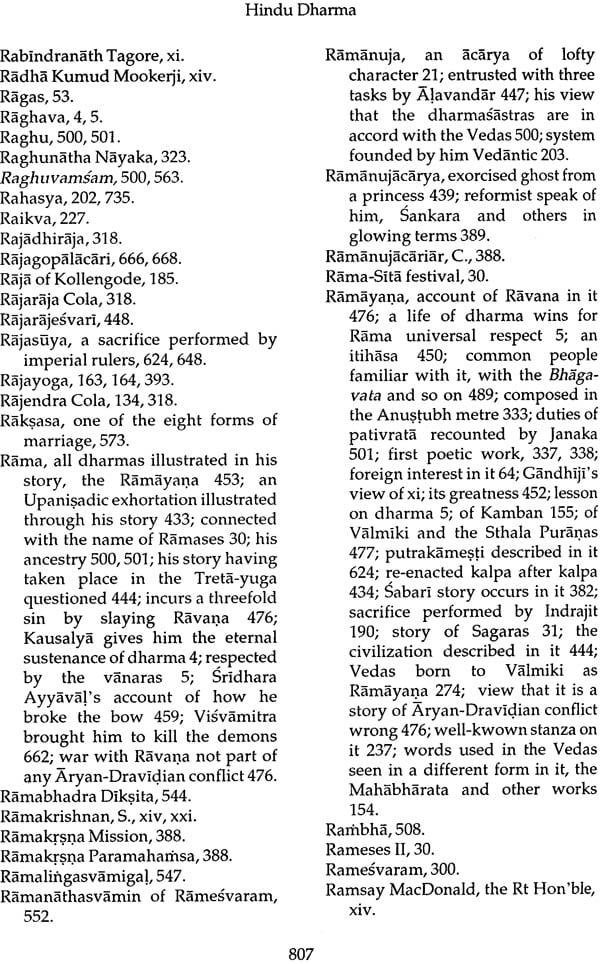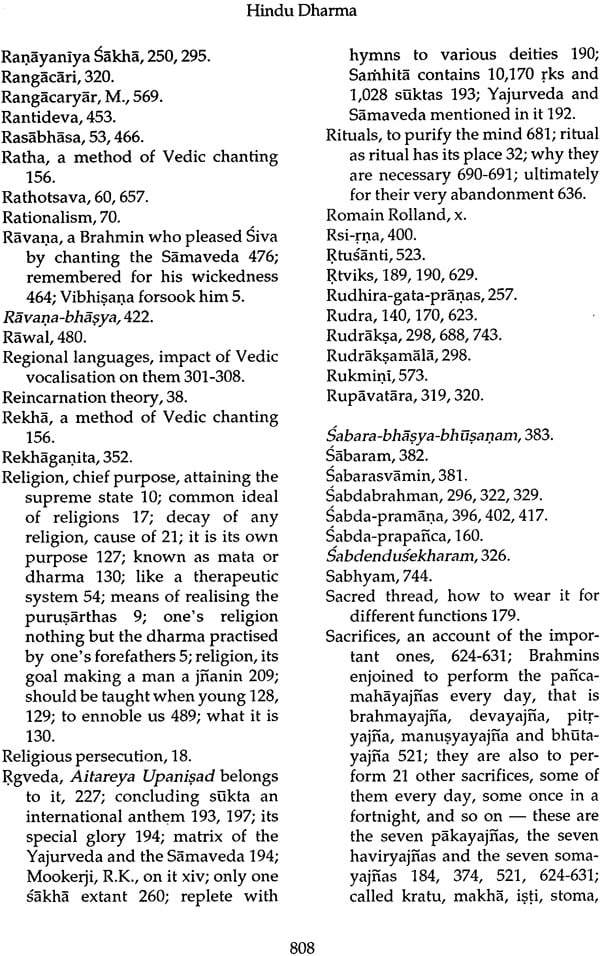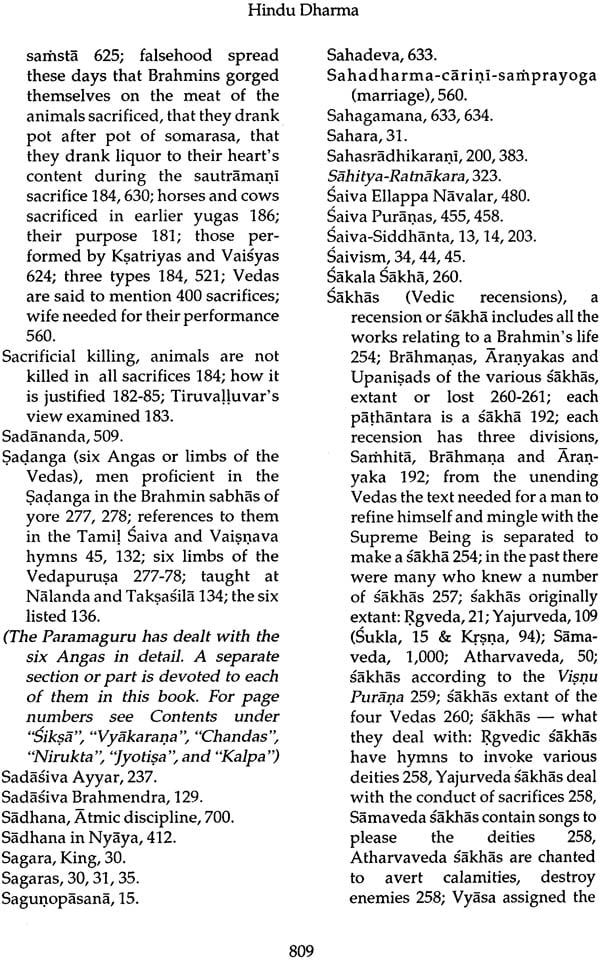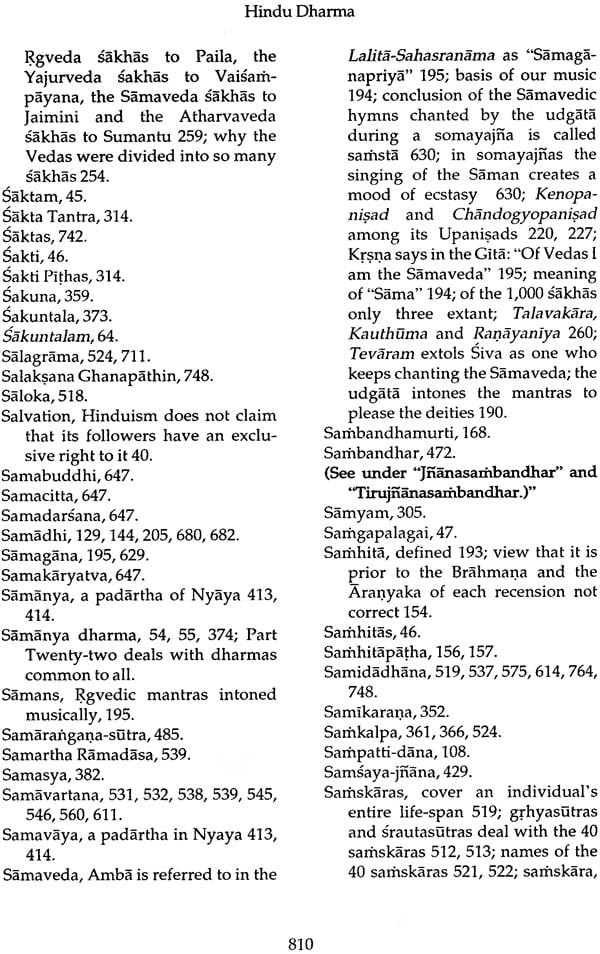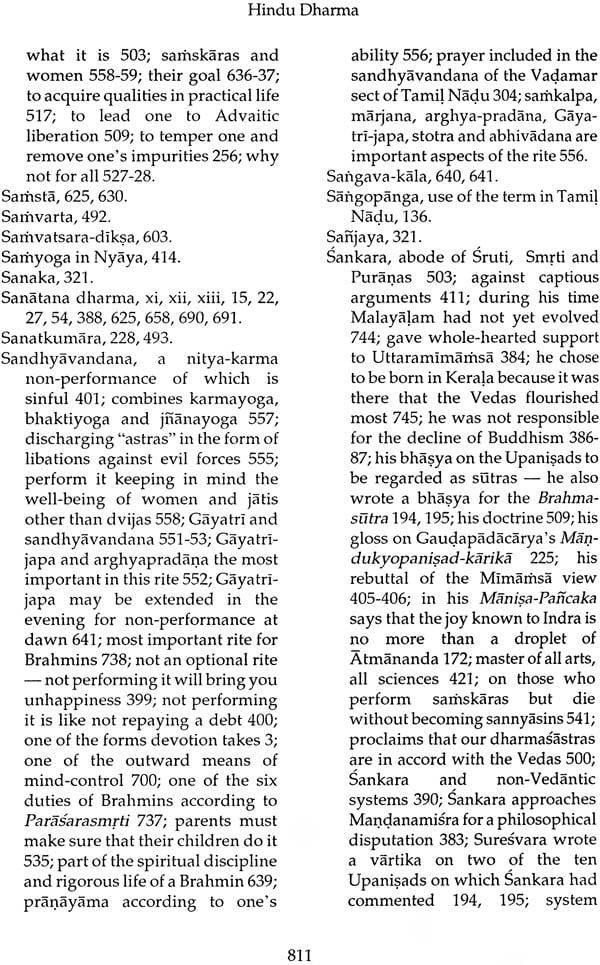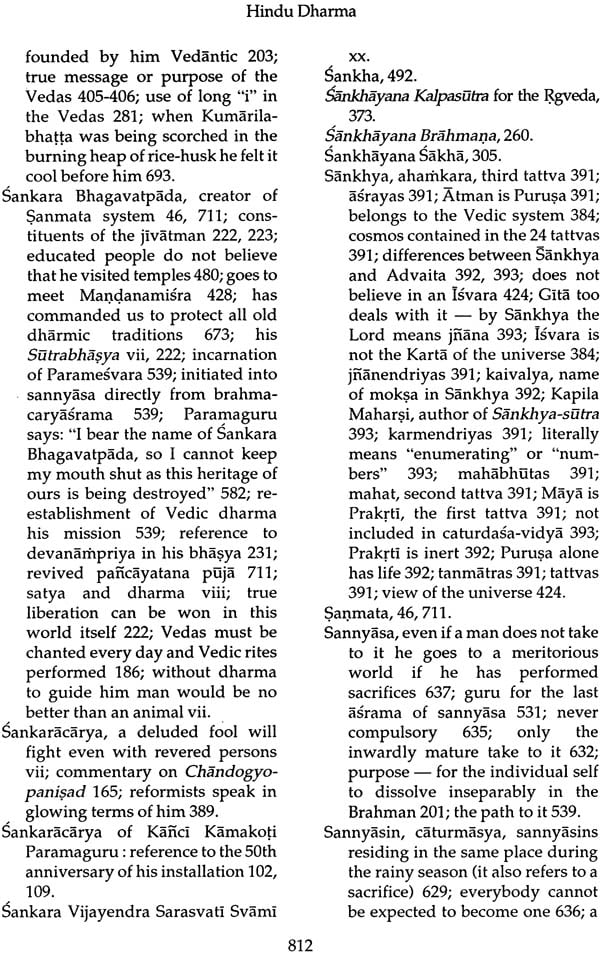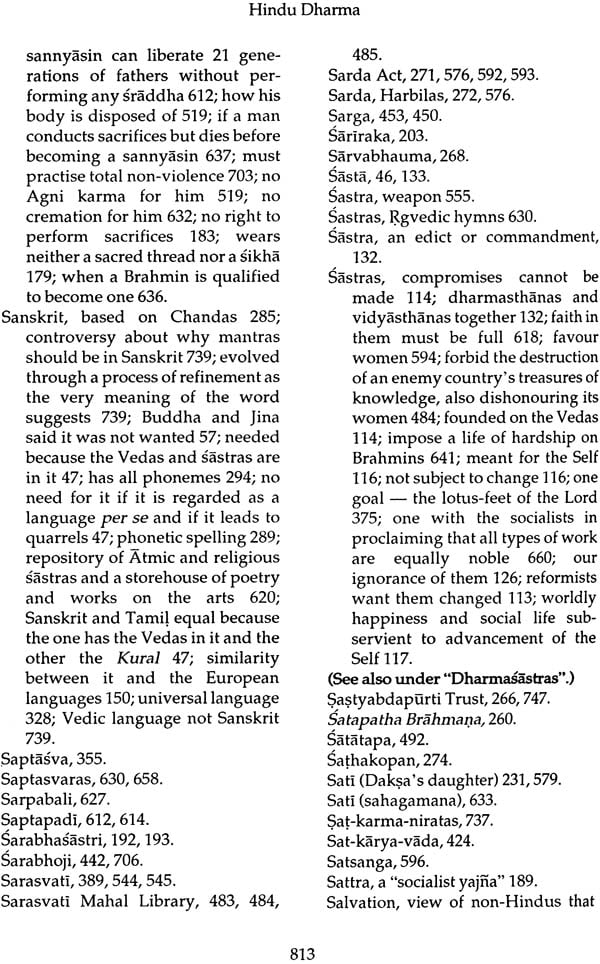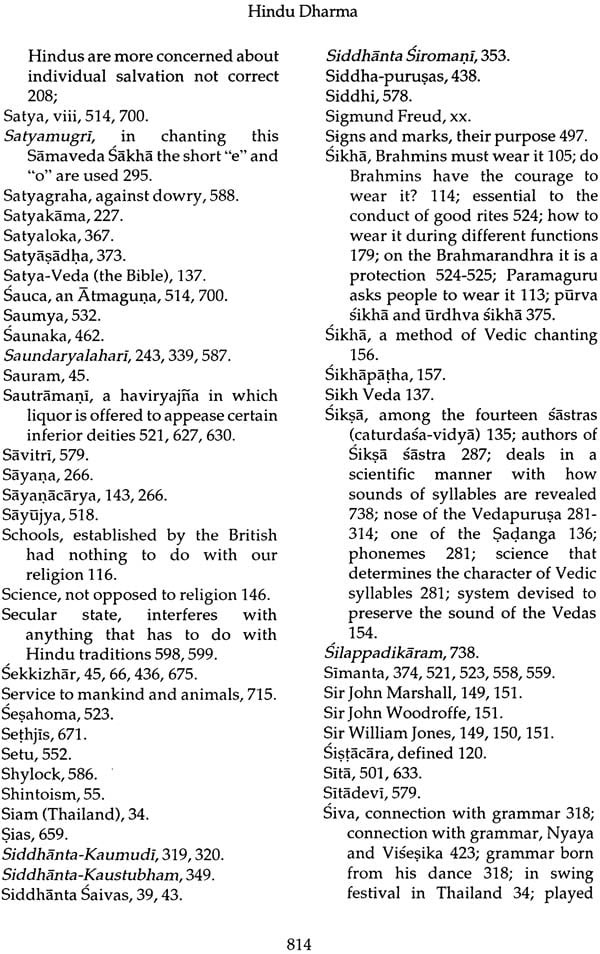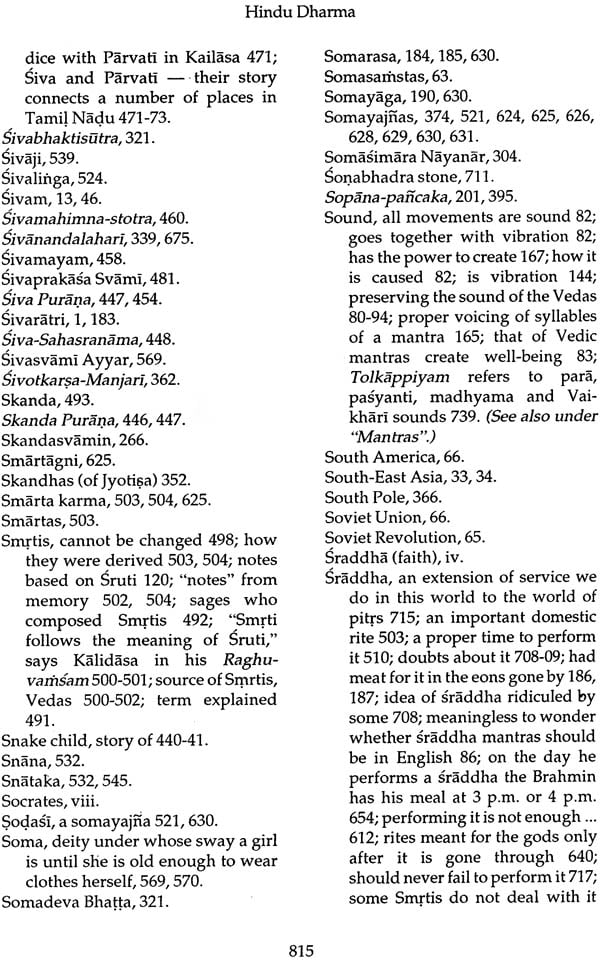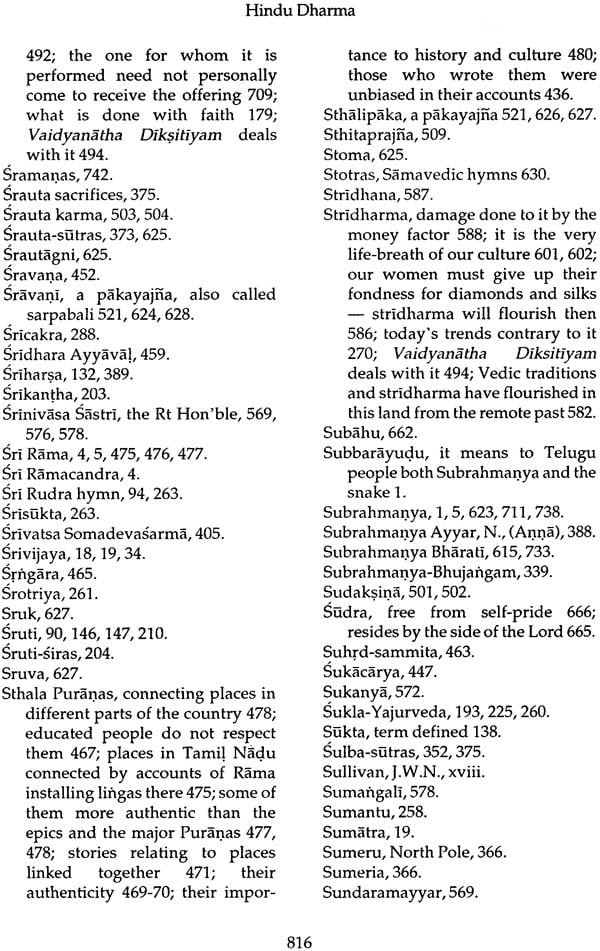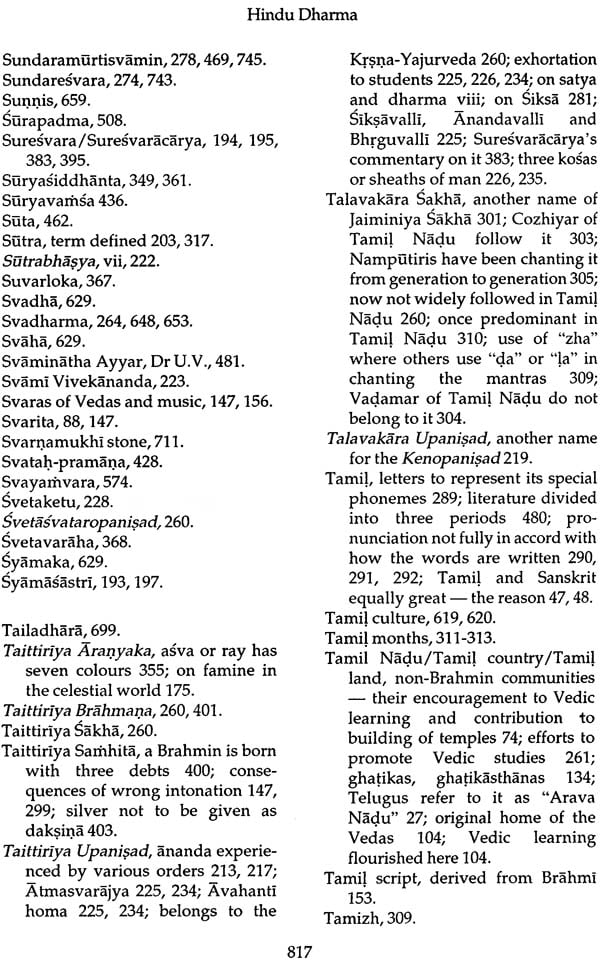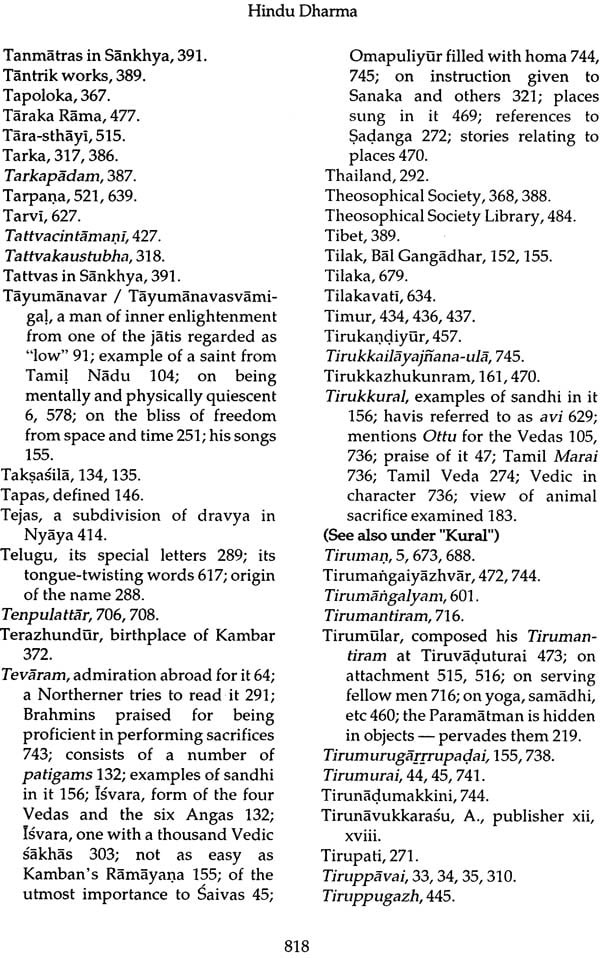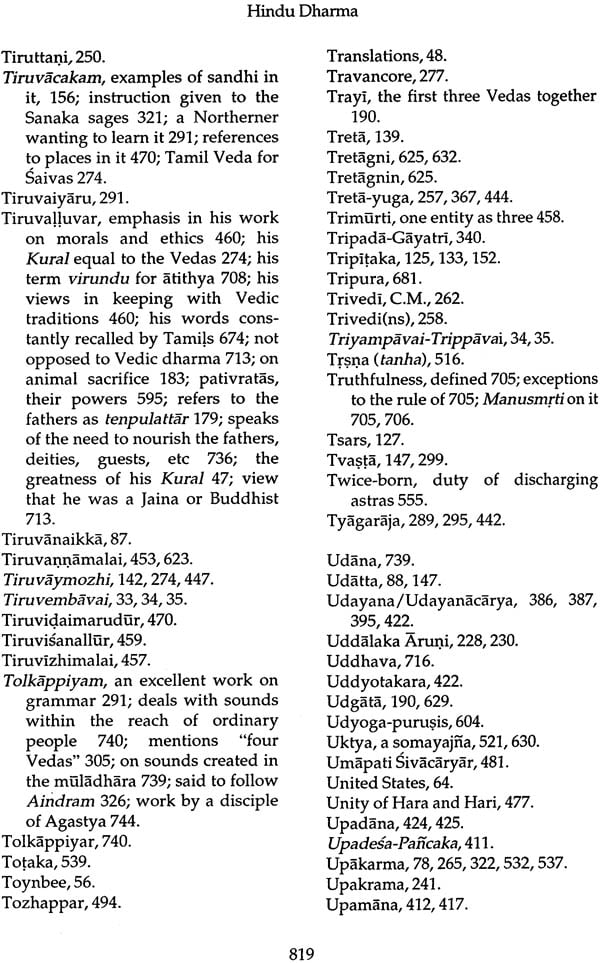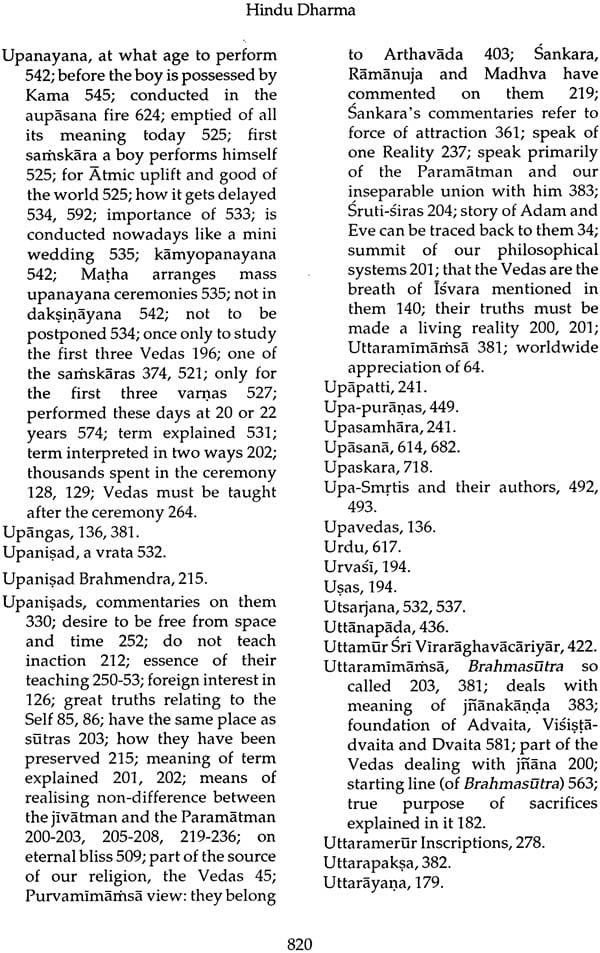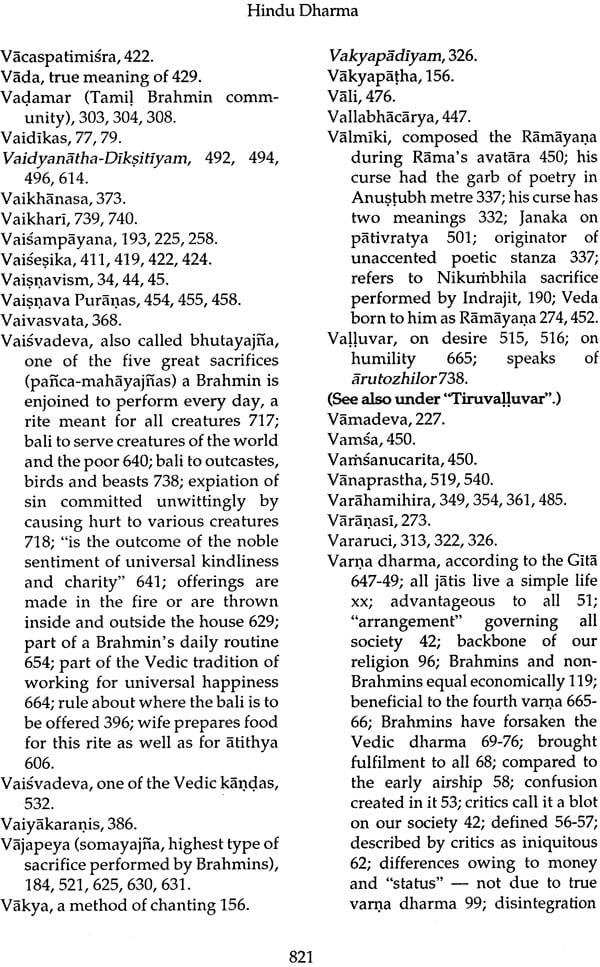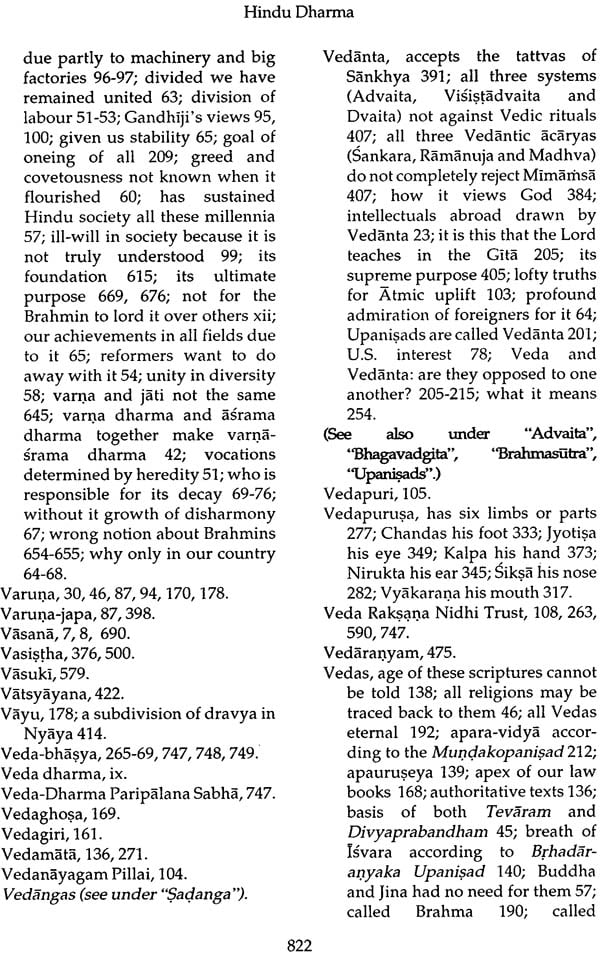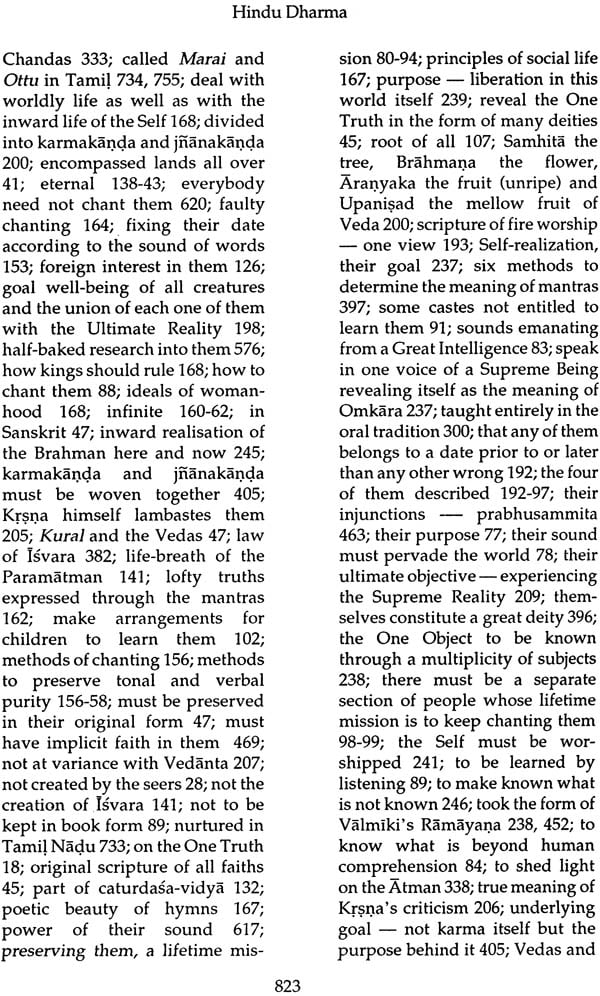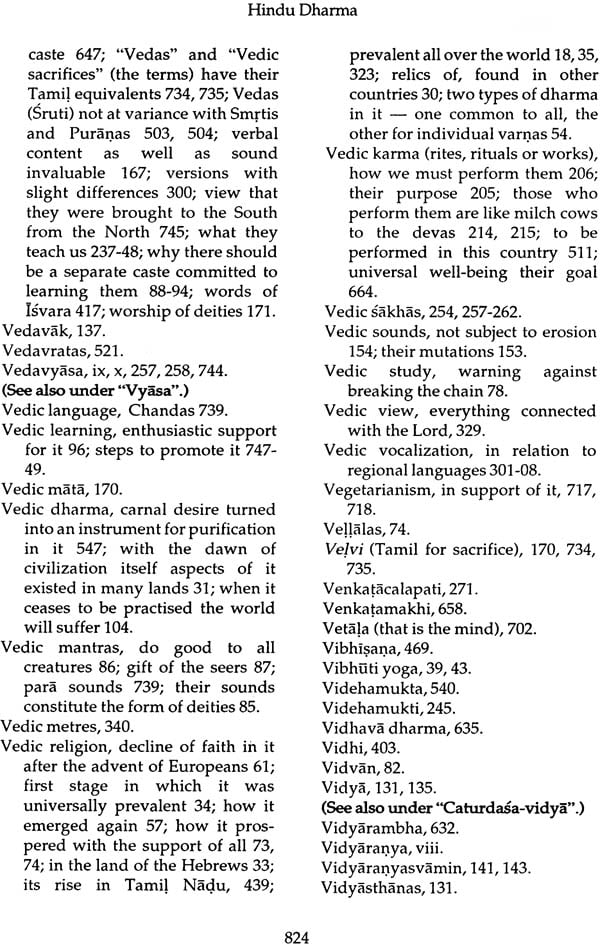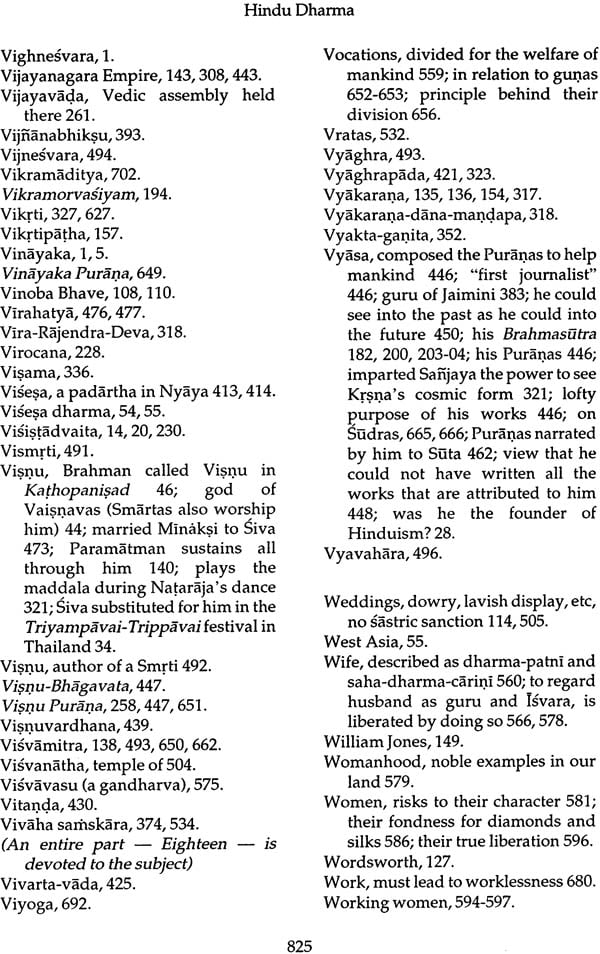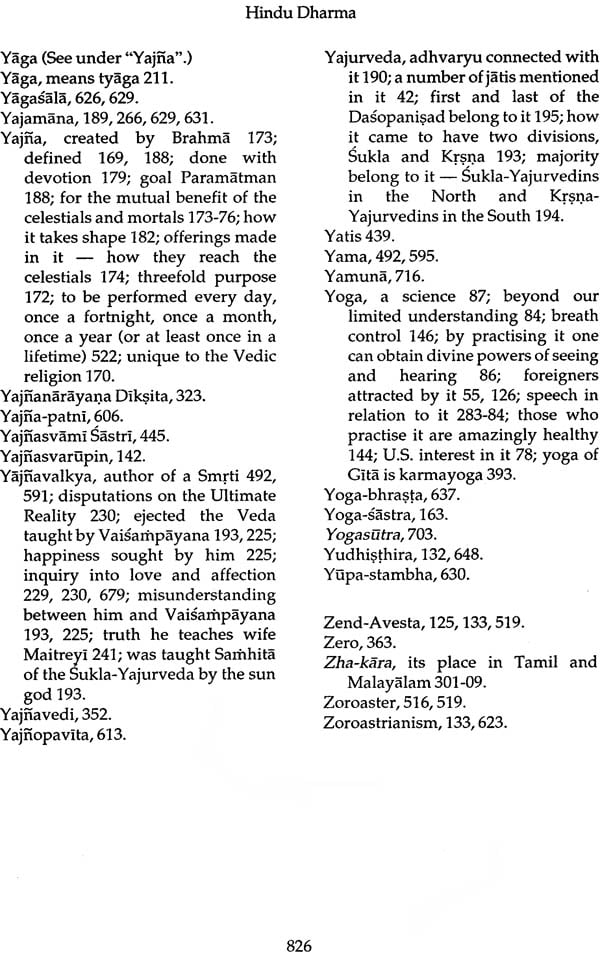
Hindu Dharma The Universal Way of Life (Voice of the Guru Pujyasri Candrasekharendra Sarasvati Svami)
Book Specification
| Item Code: | IDK663 |
| Author: | Pujyasri Candrasekharendra Sarasvati Svami |
| Publisher: | Bharatiya Vidya Bhavan |
| Language: | English |
| Edition: | 2018 |
| ISBN: | 9788172765231 |
| Pages: | 858 (7 B/W Illustrations) |
| Cover: | Hardcover |
| Other Details | 10.0 inch x 7.0 inch |
| Weight | 1.53 kg |
Book Description
From the Jacket
To deal with Hindu Dharma or, more correctly, Veda Dharma or Sanatana Dharma, within the compass of a book, is like trying to contain an ocean in a jar. It is a task that can be accomplished only by a Great Master. Such a Master was Pujyasri Candrasekharendra Sarasvati Svami who has in the discourses constituting this book given an illuminating account of Hindu Dharma in all its aspects. He has brought to bear here not only his vast erudition but also his intuitive insights and synaptic vision. It is doubtful if in modern times any other acharya has given such a lucid and comprehensive exegesis of our sastras.
The Paramaguru discusses the basic texts of Veda Dharma ? the four Vedas, the six Vedangas, Mimamsa, Nyaya, the Puranas and Dharmasastra. These encompass various systems of thought and various points of view and the Great Master tries to make them part of one unified vision that is Hinduism. He combines ancient wisdom with modern knowledge and it is thus that he finds common points between the metaphysics and physics of sound in the CHAPTER in which he expounds the Vedas and tells us why their sound must be preserved. It is all in the context of varna dharma to which we owe the achievements of our great civilization. We need Brahmins as a separate class only to preserve the Vedic dharma and work for the well-being of mankind. In the varna system the duties of the various jatis are interlinked so as to ensure cohesion and harmony in society.
Altogether it is an integrated view of Sanatana Dharma that emerges in which the ultimate Vedic message of liberation here and now is underlined.
Pujyasri Candrasekharendra Sarasvati Svami was installed as the 68th Sankaracharya of Kanci Kamakoti Pitha in 1907 when he was hardly 13 years old. His life spanned the greater part of the century and during this period of social and political ferment he was one of the guiding lights. He was a divine incarnation - indeed he was the greatest spiritual luminary of our time ? and his mission of restoring the vedic religion to its old glory was no less significant than that of Adi Sankara.
This Master of Masters was like a lambent light who rekindled the spirit of the nation and brought about a renaissance in many spheres like religion and culture. He was the voice of eternal India and he taught mankind, groping in the dark despite all the strides taken in science and technology, how to journey towards a higher destiny, how to win the highest of freedoms, the freedom of Atma-svarajya.
His compassion was as boundless as his jnana. The memory of his gentle face can never be erased from our hearts and we shall cherish it always as we shall the memory of his hand that conveyed his blessings. We still hear his godly voice brought by the wind and the waves of the sea and we still feel the infinitude of his divine presence.
Foreword
"Man is no different from animals," says Sri Sankara Bhagavatpada in his Sutrabhasya. "Pasvadibhiscavisesat."
Texts tell us: "Human beings and animals have the same urges. They eat and sleep and copulate and, besides, the feelings of fear and common to both. What, then, is the difference between the two? It is adherence to dharma that distinguishes human beings from animals. Without dharma to guide him man would be o better than an animal."
Dharmo hi tesamadhiko visesah dharmena hina pasubhissamanah"
Smrtibhramsad buddhinaso buddhinasat pranasyati
Commenting on these two slokas of the Gita, Svami Cinmayananda says that evil develops from our wrong thinking or false imagination like a tree developing from the seed. Thought has the power to create as well as to destroy. Rightly harnessed, it can be used for constructive purposes; if misused it will be the cause of our utter destruction. When our mind constantly dwells on a "sense-object", an attachment is created for that object. When we keep thinking of this object with increasing intensity, our attachment to it becomes crystallized as burning desire for the same. But as obstacles arise to the fulfillment of this desire, the force that at first caused the desire now turns into anger.
Svami Cinmayananda further observes that anyone whose intellect is in the grip of anger becomes deluded and loses his sense of discrimination since he is also deprived of his memory. A man who is the victim of anger is capable of doing anything, forgetful of himself and his relationship with other people. Sri Sankaracarya observes in this connection that a deluded fool will fight even with revered persons like his own parents and preceptors, forgetting his indebtedness to them.
Says Socrates: "The noblest of all investigations?is what man should be and what he should pursue." And Samuel Taylor Coleridge observes: "If man is not rising upward to be an angel, he is sinking downward to be a devil. He cannot stop at the beast."
It is perhaps because of his understanding of the instincts of man and the need for human actions to be inspired by dharma that the famous poet Nilakantha Diksita said: "If, even after being born a man, one does not have any sense of discrimination, it would be better for such a one to be born an animal since animals are not subject to the law that controls the senses."
Our rsis knew that "all except God will perish". Man with his capacity for discrimination must be able to grasp the truth that the Atman is not different from the Brahman. The Atman has neither a beginning nor an end. Every individual goes through a succession of births and, determined by his karma, either sinks further and further down or rises further and further up. But in life after life the Atman remains untainted.
There is a difference of opinion even among the learned as to the meaning of the word "dharma". The word is derived from "dhr" to uphold, sustain or nourish. The seers often use it in close association with "rta" and "satya". Sri Vidyaranya defines rta as the mental perception and realization of God. The Taittiriya Upanishad also uses it with "satya" and "dharma". It exhorts students to speak the truth and practice dharma ("Satyam vada"; "Dharmam cara"). According to Sankara Bhagavatpada, satya means speaking the truth and dharma means translating it (satya) into action.
"Satyamiti yathasastrarthata sa eva anusthiyamanah dharmanama bhavati."
In this connection, the explanation given by Sri K. Balasubrahmania Aiyar is relevant: "An analysis of the significance of these three words (rta, satya and dharma) brings out clearly to us the fundamental basis of dharma as the ideal for an individual. While rta denotes the mental perception and realization of truth and satya denotes the exact true expression in words of the truth as perceived by the mind, dharma is the observance, in the conduct of life, of truth. In fact, dharma is the way of life which translates into action the truth perceived by the man of insight as expressed by him truly. In short, rta is truth in thought, satya is truth in words and dharma is truth in deed."
To right-thinking people "dharma" and "satya" are interchangeable words and their goal is-as it has always been-to rise higher so as to realize Him who alone is the Truth. For them there is no pursuit higher than that of practicing truth in thought, word and deed.
"Bhutahitam" is Sri Sankaracarya's answer to the question (that e himself raised), "Kim satyam?" It means that truth (or truthfulness) is what is spoken for the well-being of all living beings. To the question, "Ko dharmah?", his answer is "Abhimato yah sistanam nija kulinam." It means that dharma is that which is determined by the elders and by learned people.
Of the four purusharthas or aims of life, dharma is always mentioned first, artha second, kama third and moksha last. The four stanzas of the Mahabharata that together go by the name of "Bharata-Savitri" contain these profound truths: Dharma is eternal but neither happiness nor sorrow is eternal; the Atman is everlasting but not that which embodies it; and from dharma arise artha and kama. They also contain Vedavyasa's lamentation: "With uplifted arms I cry but no one listens to me, 'From dharma spring artha and kama. Why is dharma then not practiced?"
Sri Sankara Bhagavatpada observes that even the wise and the learned, even men who have a vision of the exceedingly subtle Atman, are overpowered by tamas and do not understand it even though clearly explained in various texts.
The Reality is perceived by one who has sraddha or faith which, according to the saints, is acceptance of the truth as proclaimed by the scriptures and as taught by the guru. By following the reasoning of the sastras and the path shown by the guru the bonds of avidya are broken and one becomes aware of the Atman. One's own experience obtained through one-pointed meditation of the Truth is another means to achieve the same goal. These movements are indeed blessed, the moments during which the Truth dawns on us as we receive instruction from our guru and as we gain wisdom that is supported by the authority of the scriptures. Yes, these indeed are moments of bliss when the senses are quietened and the mind is firmly fixed on the Atman. Thus dharma, to be precise Veda Dharma, has been and is essential for man to become a real man.
According to Sri Candrasekharendra Sarasvati, the Mahasvami, dharma is our only protection. In this book, the Great Acarya recounts all that we need to know about dharma and presents in an integrated form the various systems of thought that have flourished in this country. "The Vedas," Sri Mahasvami affirms, "represent the lofty principle that it is the One Truth that is envisaged as all that we perceive."
The discourses that make up this book are remarkable for their simple and enchanting style. The most complex of ideas are explained with such lucidity as to make them comprehensible to the ordinary reader. Sri Mahasvami deals not only with the wisdom of the Samhita part of the Vedas and with other scriptural matter, he takes in his stride even modern scientific concepts like those of time and space. It is all at once so wide-ranging and so profound that we bow our heads in reverence to the Great Master of our time, the Sage of Kamakoti Pitha. His approach shows that he has no doubts in his mind, no hesitation in affirming the truths contained in the Vedas and the sastras:
"The point to be noted is that if you believe in the sastras, you must believe in them fully. If you are an atheist, you could of course reject all the sastras. But to make a show of being very clever and twist the sastras as you like, accepting some parts and rejecting and changing some others, is an offence more grave than that of being an atheist. To think that Mother Veda should dance to your tune is also a great offence. Learning the Vedas with such an attitude is tantamount to ridiculing them.
"I am not angry with the reformists, nor do I suspect their intentions. They go wrong because of their ignorance and thoughtlessness. If they wish to pull down the fence so as to go to the other side, they must think of the possibility of the few still remaining there crossing over to this side."
The Great Acharya has commanded us to protect the old dharmic traditions and keep them alive :
"All old dharmic traditions must be protected and kept alive. Sri Sankara Bhagavatpada has commanded us to do so. I bear his name; so it is my duty to remind you of his command. Whether or not you will heed his command, I should like to impress upon you that the sastric customs have the purpose of ensuring the good of all mankind."
I am aware of the alarm sounded by Vedavyasa, but I still sincerely believe that the words of the Great Master of our time shall rekindle the lamp of wisdom and lead us from darkness unto light. It is my great privilege to write the Foreword to this book. The translator has done a service to people like us who believe in the saha-chintan and the words of the Yajurveda :
"Vayam raster jagryama purohitah.
Let us be awake and alert to the noble cause of the nation, to the India of the Rgveda ? our svadesa from the Himavan to the ocean. There is need for a fresh commitment on the part of its people to the ideal expressed by the time-honoured saying, "Janani janmabhumisca svargadapi gariyasi."
Preface
When India was straining at the leash during the unique "weaponless war" conceived, planned and led by Mahatma Gandhi to win freedom, some of the finest flowers of India manhood and womanhood were forced to languish in prison for long years. During his ninth incarceration, this time in the Ahmadnagar fort Prison (August 9, 1942 to July 15, 1945), Pandit Jawaharlal Nehru, one of the best among them embarked upon a voyage of "Discovery of India". He "discovered" for himself and for us, the common people, an Indian that is "a myth and an idea, a dream and a vision and yet very real and pervasive."
Nehru, with the poetic touch so characteristic of him, looked upon India as "a lady with a glorious past, whose deep eyes had seen so much of life's passion and joy and folly and looked deep down into wisdom's well." It is this "wisdom's well" that is represented by our Vedic heritage, the "living words", as Gurudeva Rabindranath Tagore put it, "that have issued from the Illuminated Consciousness of our great ones."
This offering of Hindu Dharma: The Universal Way of Life deals with another kind of discovery of India, a discovery in the spiritual realm, made by Jagadguru Sri Candrasekharendra Sarasvati Svamigal, the 68th Sankaracarya of Kanci Kamakoti Pitha. The Sage of Kanci was spiritually supreme, intellectually pre-eminent. He was verily an akspayapatra ? inexhaustible reservoir ? of the spiritual wisdom of India dating back to the beginning of Time, and of Vedic Dharma. So was he with regard to modern knowledge, current affairs and contemporary men and matters.
In a special eassy in the Bhavan's Journal, this true sanatani hailed Gandhiji, a staunch Hindu and a secularist nonpareil, as one of the "greatest redeemers of Hinduism". Hailing Gandhiji's services to Hinduism, he said: "From the time Gandhiji came into the arena, he augmented his political movements by his spiritual researches and devotion. Almost all the features of Hinduism that were discarded as weeds by the previous reform movements were clearly explained by Gandhiji is being of indispensable utility. His views on Ramanama, the Ramayana, varna dharma, aharaniyama and his definition of God are such that the most faithful Hindu cannot but profit spiritually by digesting them."
During one of the satsangas some members of the Bhavan's family were privileged to have with him, this remarkable advaitin said that Jawaharlal Nehru was "an advaitin at heart."
| Foreword by Sri Justice P.S. Mishra | vii | |
| Preface | xi | |
| Introduction | xv | |
| Translator's Note | xvii | |
| Key to Pronunciation | xxiii | |
| For the Reader's Attention | xxv | |
| PART ONE: | RELIGION IN GENERAL | 1-20 |
| PART TWO: | THE VEDIC RELIGION: INTRODUCTORY | 27-47 |
| PART THREE: | THE VEDIC RELIGION AND VARNA DHARMA | 51-101 |
| PART FOUR: | THE SASTRAS AND MODERN LIFE | 113-120 |
| PART FIVE: | THE VEDAS | 125-276 |
| PART SIX: | SIKSA | 281-314 |
| PART SEVEN: | VYAKARANA | 315-329 |
| PART EIGHT: | CHANDAS | 333-342 |
| PART NINE: | NIRUKTA | 345 |
| PART TEN: | JYOTISA | 349-369 |
| PART ELEVEN: | KALP A | 373 |
| PART TWELVE: | MIMAMSA-KARMAMARGA | 381-408 |
| PART THIRTEEN: | NYAYA | 411-427 |
| PART FOURTEEN: | PURANAS | 433-483 |
| PART FIFTEEN: | DHARMASASTRA | 489-503 |
| PART SIXTEEN: | THE FORTY SAMSKARAS | 507-527 |
| PART SEVENTEEN: | BRAHMACARYASRAMA | 531-560 |
| PART EIGHTEEN: | MARRIAGE | 563-606 |
| PART NINETEEN: | GRHASTHASRAMA | 611-639 |
| PART TWENTY: | VARNA DHARMA FOR UNIVERSAL WELL-BEING | 645-674 |
| PART TWENTY-ONE: | FROM WORK TO WORKLESSNESS | 679-694 |
| PART TWENTY-TWO: | DHARMAS COMMON TO ALL | 699-729 |
| APPENDICES | 733-747 | |
| SANSKRIT GLOSSARY | 751 | |
| TAMIL GLOSSARY | 767 | |
| INDEX | 777 |
